Labor Market Trends in UK and Kuwait
VerifiedAdded on 2023/04/19
|30
|6417
|285
AI Summary
This article discusses the contemporary labor market trends in the United Kingdom (UK) and Kuwait, including factors such as de-industrialization, increase in the service sector, implementation of the national minimum wage, zero hour contracts, and increase in the participation of female labor. It also explores the strategic positioning of organizations in the competitive labor market and the significance of tight and loose labor market conditions. Additionally, it examines the role of government, employers, and trade unions in meeting future skill needs of labor, and describes the main principles of effective workforce planning with examples of tools used.
Contribute Materials
Your contribution can guide someone’s learning journey. Share your
documents today.
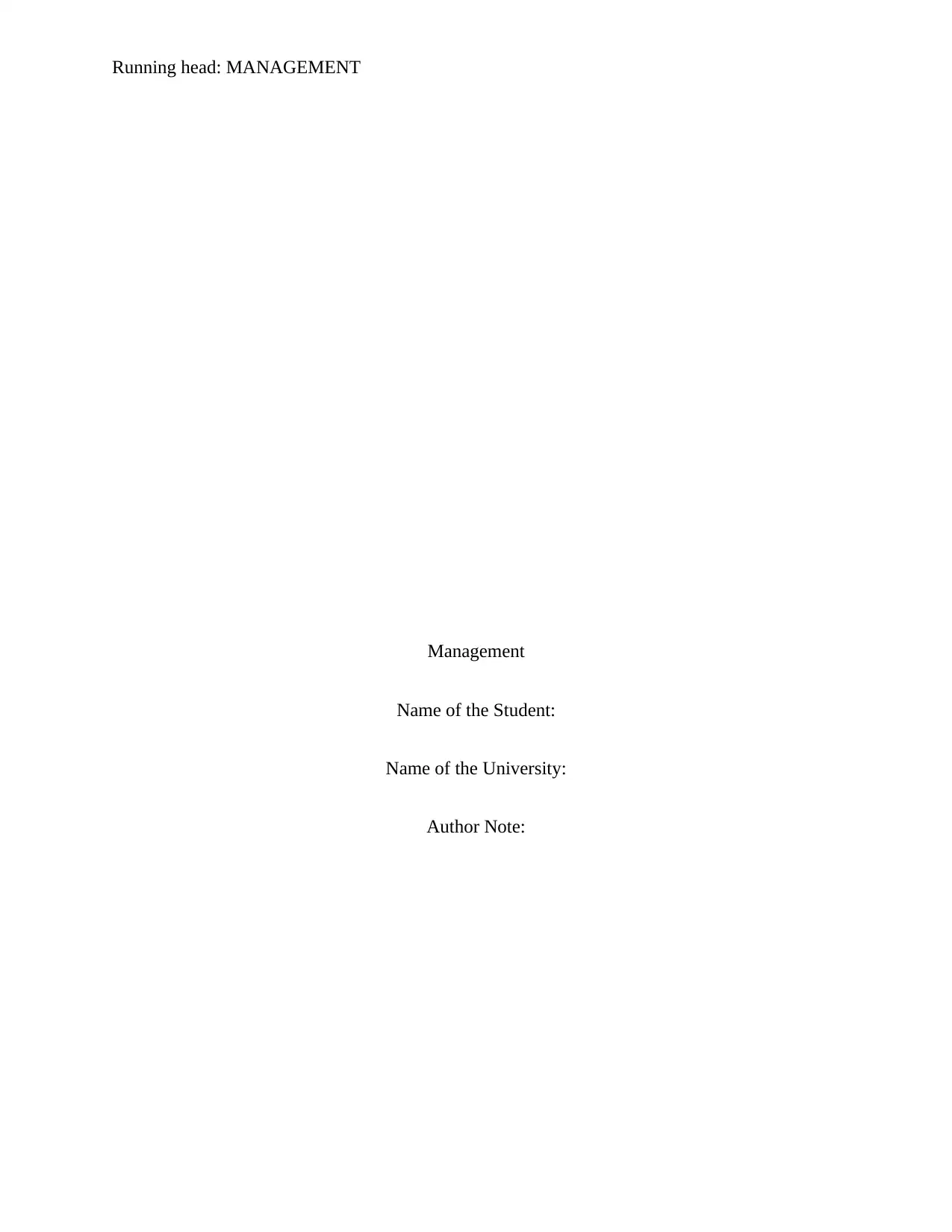
Running head: MANAGEMENT
Management
Name of the Student:
Name of the University:
Author Note:
Management
Name of the Student:
Name of the University:
Author Note:
Secure Best Marks with AI Grader
Need help grading? Try our AI Grader for instant feedback on your assignments.
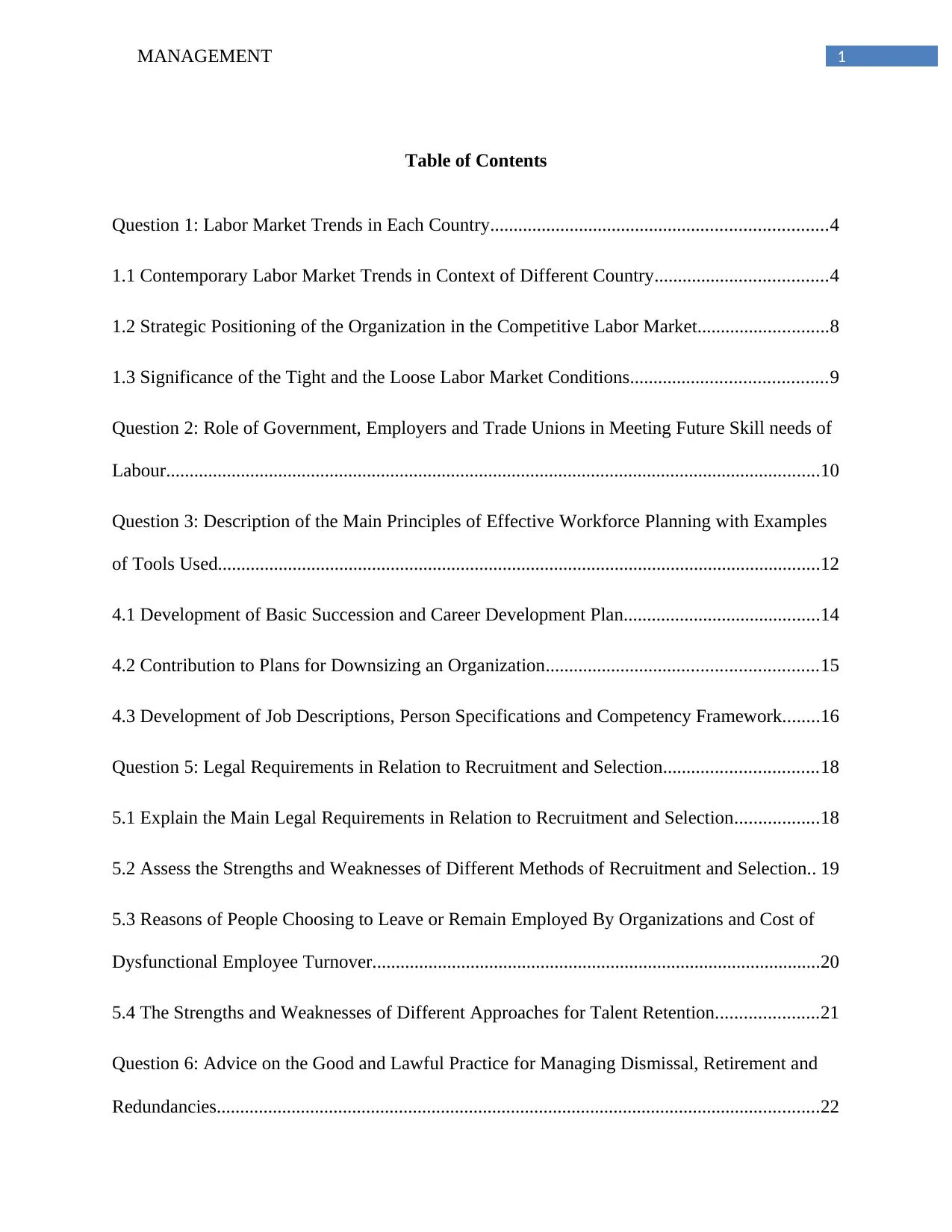
1MANAGEMENT
Table of Contents
Question 1: Labor Market Trends in Each Country........................................................................4
1.1 Contemporary Labor Market Trends in Context of Different Country.....................................4
1.2 Strategic Positioning of the Organization in the Competitive Labor Market............................8
1.3 Significance of the Tight and the Loose Labor Market Conditions..........................................9
Question 2: Role of Government, Employers and Trade Unions in Meeting Future Skill needs of
Labour............................................................................................................................................10
Question 3: Description of the Main Principles of Effective Workforce Planning with Examples
of Tools Used.................................................................................................................................12
4.1 Development of Basic Succession and Career Development Plan..........................................14
4.2 Contribution to Plans for Downsizing an Organization..........................................................15
4.3 Development of Job Descriptions, Person Specifications and Competency Framework........16
Question 5: Legal Requirements in Relation to Recruitment and Selection.................................18
5.1 Explain the Main Legal Requirements in Relation to Recruitment and Selection..................18
5.2 Assess the Strengths and Weaknesses of Different Methods of Recruitment and Selection.. 19
5.3 Reasons of People Choosing to Leave or Remain Employed By Organizations and Cost of
Dysfunctional Employee Turnover................................................................................................20
5.4 The Strengths and Weaknesses of Different Approaches for Talent Retention......................21
Question 6: Advice on the Good and Lawful Practice for Managing Dismissal, Retirement and
Redundancies.................................................................................................................................22
Table of Contents
Question 1: Labor Market Trends in Each Country........................................................................4
1.1 Contemporary Labor Market Trends in Context of Different Country.....................................4
1.2 Strategic Positioning of the Organization in the Competitive Labor Market............................8
1.3 Significance of the Tight and the Loose Labor Market Conditions..........................................9
Question 2: Role of Government, Employers and Trade Unions in Meeting Future Skill needs of
Labour............................................................................................................................................10
Question 3: Description of the Main Principles of Effective Workforce Planning with Examples
of Tools Used.................................................................................................................................12
4.1 Development of Basic Succession and Career Development Plan..........................................14
4.2 Contribution to Plans for Downsizing an Organization..........................................................15
4.3 Development of Job Descriptions, Person Specifications and Competency Framework........16
Question 5: Legal Requirements in Relation to Recruitment and Selection.................................18
5.1 Explain the Main Legal Requirements in Relation to Recruitment and Selection..................18
5.2 Assess the Strengths and Weaknesses of Different Methods of Recruitment and Selection.. 19
5.3 Reasons of People Choosing to Leave or Remain Employed By Organizations and Cost of
Dysfunctional Employee Turnover................................................................................................20
5.4 The Strengths and Weaknesses of Different Approaches for Talent Retention......................21
Question 6: Advice on the Good and Lawful Practice for Managing Dismissal, Retirement and
Redundancies.................................................................................................................................22
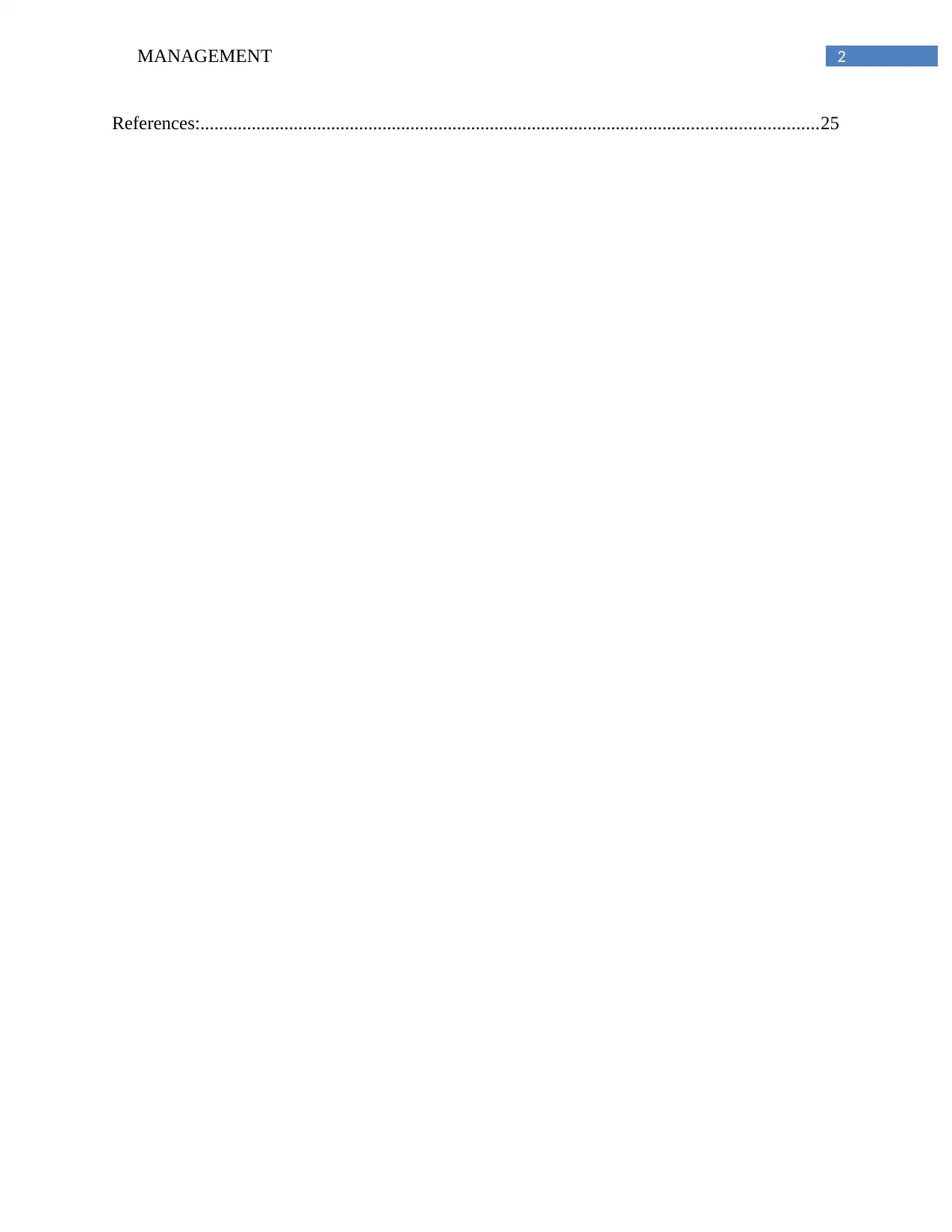
2MANAGEMENT
References:....................................................................................................................................25
References:....................................................................................................................................25
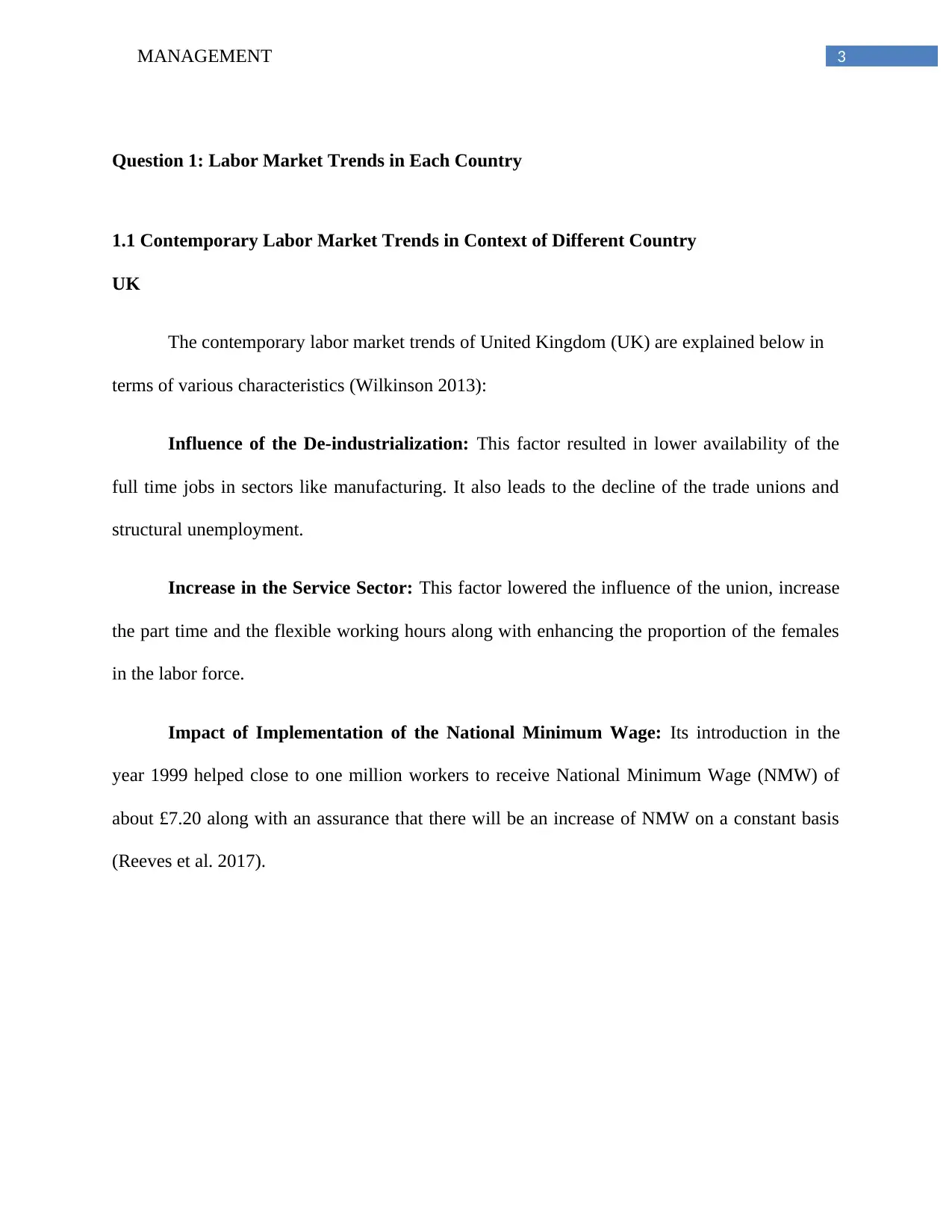
3MANAGEMENT
Question 1: Labor Market Trends in Each Country
1.1 Contemporary Labor Market Trends in Context of Different Country
UK
The contemporary labor market trends of United Kingdom (UK) are explained below in
terms of various characteristics (Wilkinson 2013):
Influence of the De-industrialization: This factor resulted in lower availability of the
full time jobs in sectors like manufacturing. It also leads to the decline of the trade unions and
structural unemployment.
Increase in the Service Sector: This factor lowered the influence of the union, increase
the part time and the flexible working hours along with enhancing the proportion of the females
in the labor force.
Impact of Implementation of the National Minimum Wage: Its introduction in the
year 1999 helped close to one million workers to receive National Minimum Wage (NMW) of
about £7.20 along with an assurance that there will be an increase of NMW on a constant basis
(Reeves et al. 2017).
Question 1: Labor Market Trends in Each Country
1.1 Contemporary Labor Market Trends in Context of Different Country
UK
The contemporary labor market trends of United Kingdom (UK) are explained below in
terms of various characteristics (Wilkinson 2013):
Influence of the De-industrialization: This factor resulted in lower availability of the
full time jobs in sectors like manufacturing. It also leads to the decline of the trade unions and
structural unemployment.
Increase in the Service Sector: This factor lowered the influence of the union, increase
the part time and the flexible working hours along with enhancing the proportion of the females
in the labor force.
Impact of Implementation of the National Minimum Wage: Its introduction in the
year 1999 helped close to one million workers to receive National Minimum Wage (NMW) of
about £7.20 along with an assurance that there will be an increase of NMW on a constant basis
(Reeves et al. 2017).
Secure Best Marks with AI Grader
Need help grading? Try our AI Grader for instant feedback on your assignments.
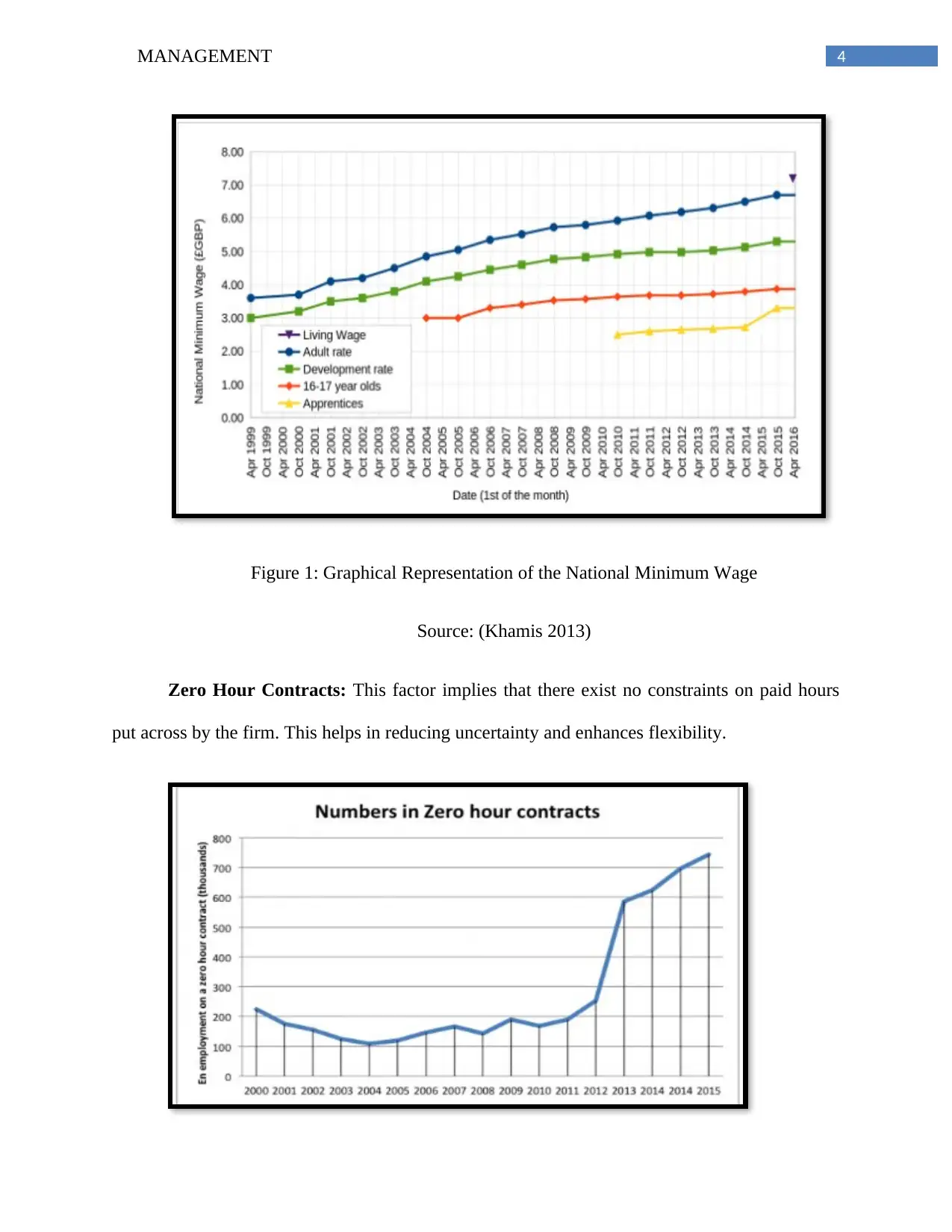
4MANAGEMENT
Figure 1: Graphical Representation of the National Minimum Wage
Source: (Khamis 2013)
Zero Hour Contracts: This factor implies that there exist no constraints on paid hours
put across by the firm. This helps in reducing uncertainty and enhances flexibility.
Figure 1: Graphical Representation of the National Minimum Wage
Source: (Khamis 2013)
Zero Hour Contracts: This factor implies that there exist no constraints on paid hours
put across by the firm. This helps in reducing uncertainty and enhances flexibility.
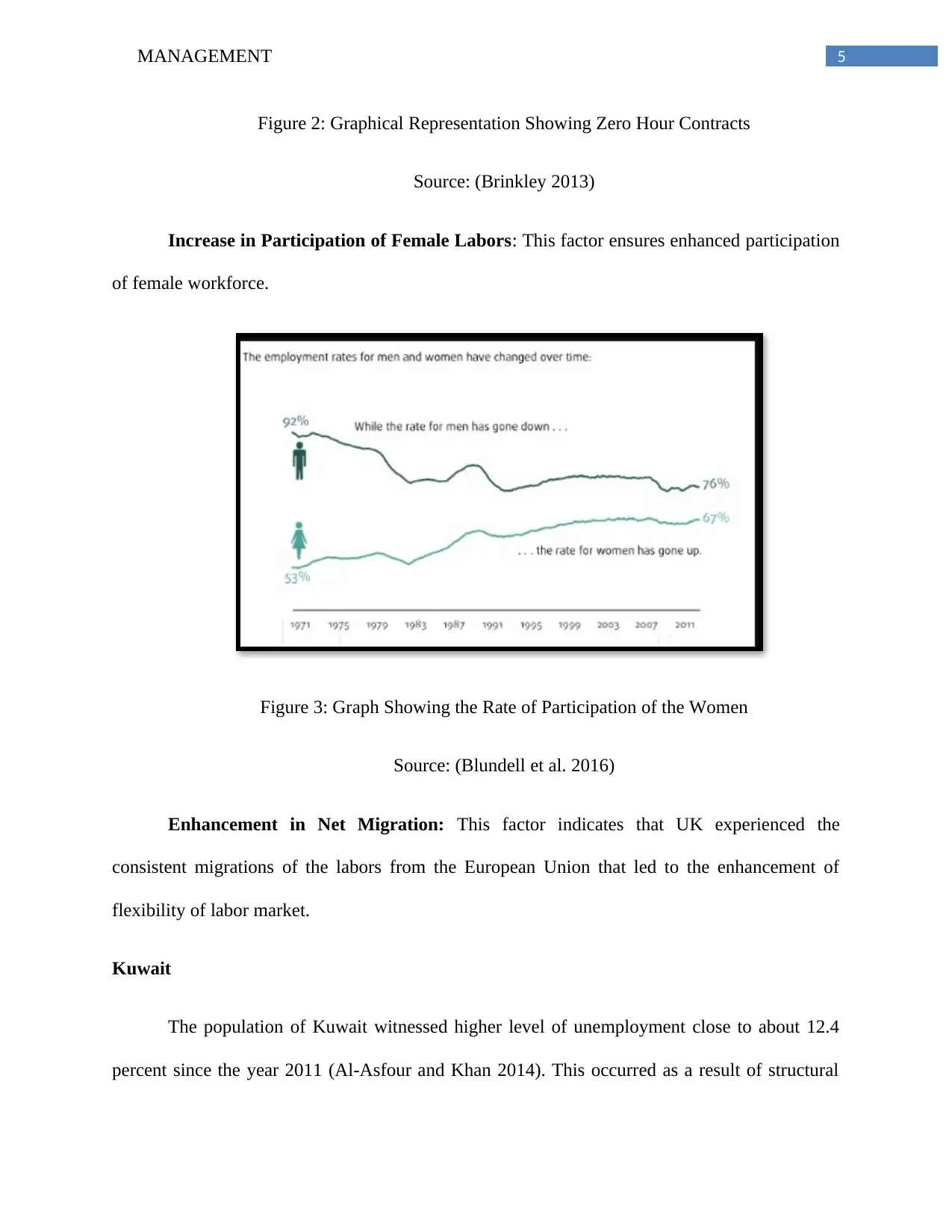
5MANAGEMENT
Figure 2: Graphical Representation Showing Zero Hour Contracts
Source: (Brinkley 2013)
Increase in Participation of Female Labors: This factor ensures enhanced participation
of female workforce.
Figure 3: Graph Showing the Rate of Participation of the Women
Source: (Blundell et al. 2016)
Enhancement in Net Migration: This factor indicates that UK experienced the
consistent migrations of the labors from the European Union that led to the enhancement of
flexibility of labor market.
Kuwait
The population of Kuwait witnessed higher level of unemployment close to about 12.4
percent since the year 2011 (Al-Asfour and Khan 2014). This occurred as a result of structural
Figure 2: Graphical Representation Showing Zero Hour Contracts
Source: (Brinkley 2013)
Increase in Participation of Female Labors: This factor ensures enhanced participation
of female workforce.
Figure 3: Graph Showing the Rate of Participation of the Women
Source: (Blundell et al. 2016)
Enhancement in Net Migration: This factor indicates that UK experienced the
consistent migrations of the labors from the European Union that led to the enhancement of
flexibility of labor market.
Kuwait
The population of Kuwait witnessed higher level of unemployment close to about 12.4
percent since the year 2011 (Al-Asfour and Khan 2014). This occurred as a result of structural
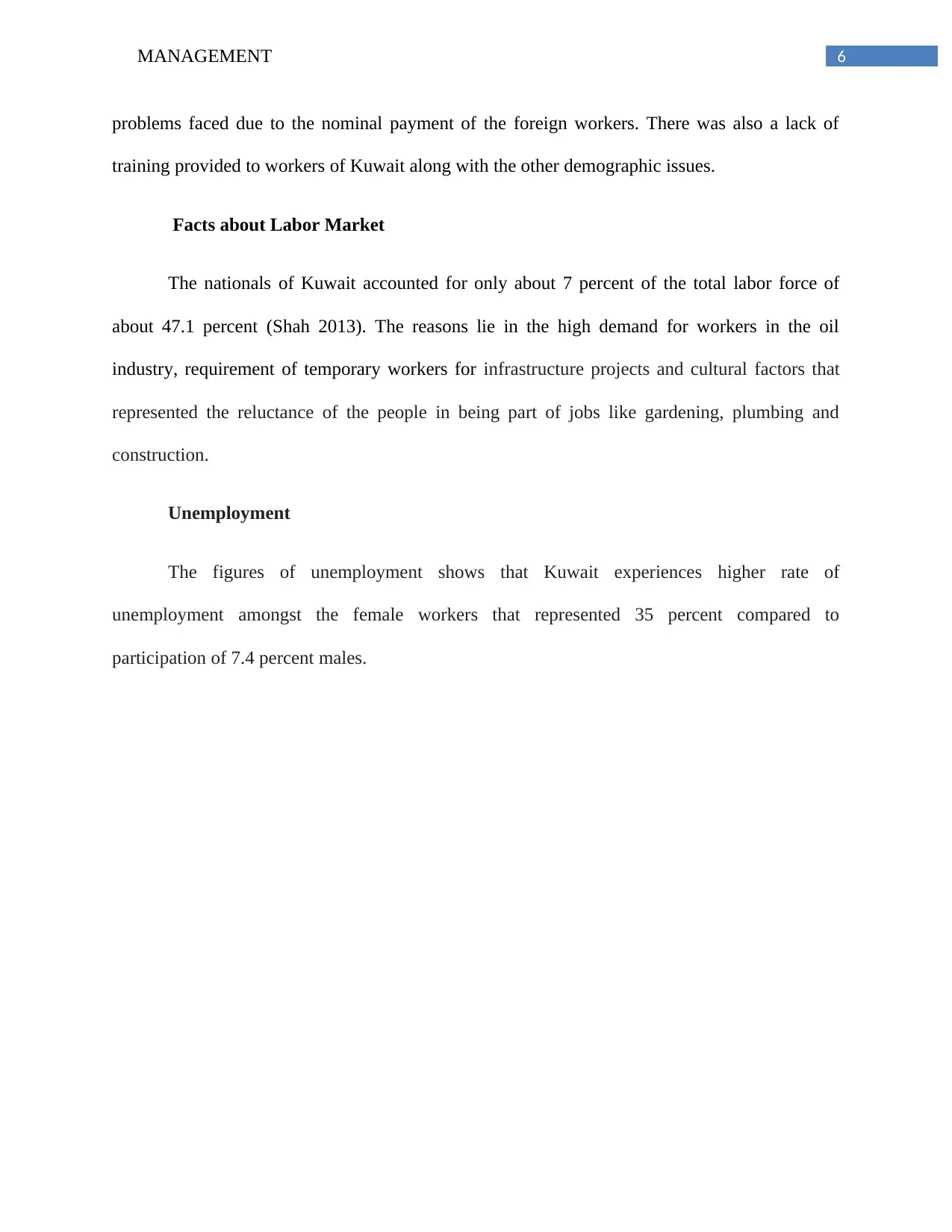
6MANAGEMENT
problems faced due to the nominal payment of the foreign workers. There was also a lack of
training provided to workers of Kuwait along with the other demographic issues.
Facts about Labor Market
The nationals of Kuwait accounted for only about 7 percent of the total labor force of
about 47.1 percent (Shah 2013). The reasons lie in the high demand for workers in the oil
industry, requirement of temporary workers for infrastructure projects and cultural factors that
represented the reluctance of the people in being part of jobs like gardening, plumbing and
construction.
Unemployment
The figures of unemployment shows that Kuwait experiences higher rate of
unemployment amongst the female workers that represented 35 percent compared to
participation of 7.4 percent males.
problems faced due to the nominal payment of the foreign workers. There was also a lack of
training provided to workers of Kuwait along with the other demographic issues.
Facts about Labor Market
The nationals of Kuwait accounted for only about 7 percent of the total labor force of
about 47.1 percent (Shah 2013). The reasons lie in the high demand for workers in the oil
industry, requirement of temporary workers for infrastructure projects and cultural factors that
represented the reluctance of the people in being part of jobs like gardening, plumbing and
construction.
Unemployment
The figures of unemployment shows that Kuwait experiences higher rate of
unemployment amongst the female workers that represented 35 percent compared to
participation of 7.4 percent males.
Paraphrase This Document
Need a fresh take? Get an instant paraphrase of this document with our AI Paraphraser
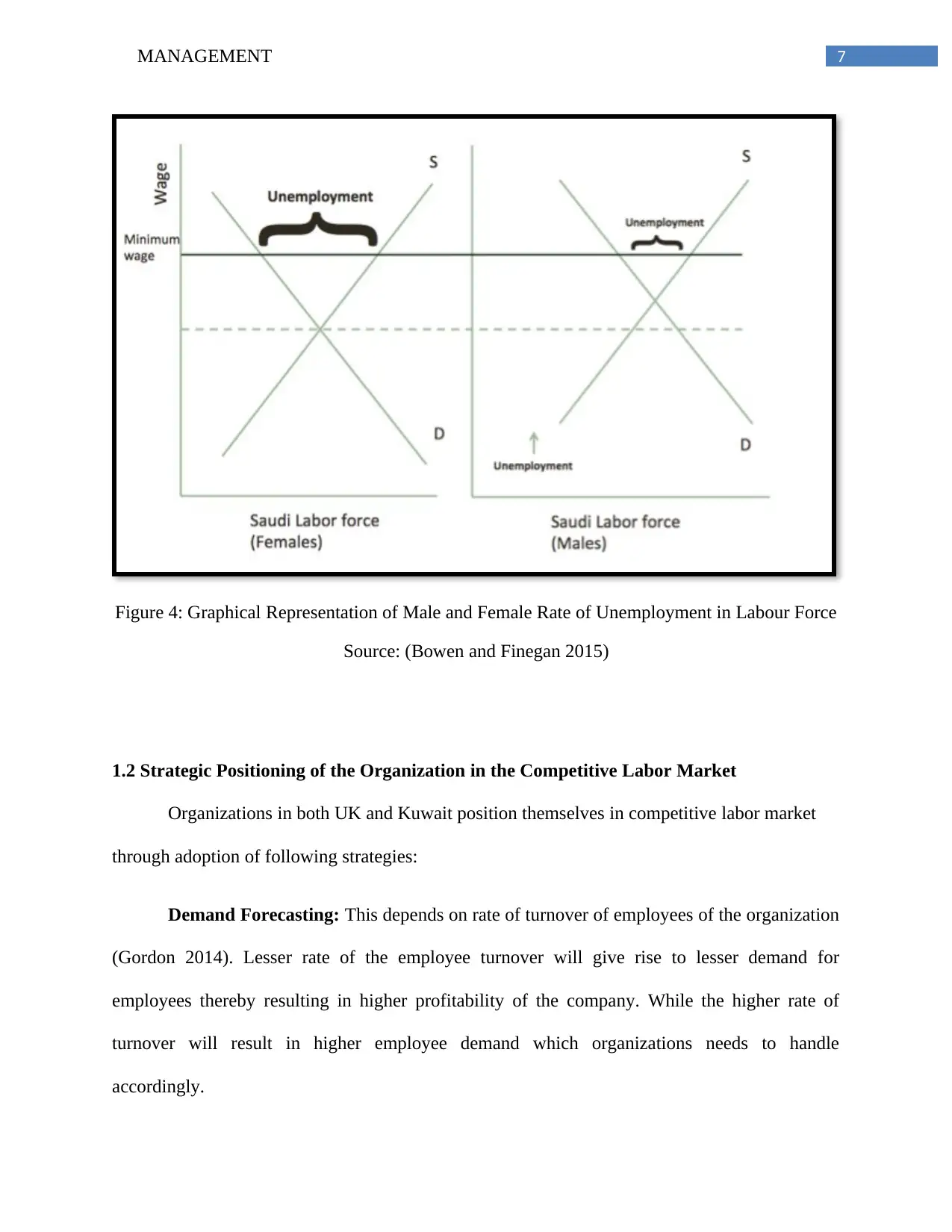
7MANAGEMENT
Figure 4: Graphical Representation of Male and Female Rate of Unemployment in Labour Force
Source: (Bowen and Finegan 2015)
1.2 Strategic Positioning of the Organization in the Competitive Labor Market
Organizations in both UK and Kuwait position themselves in competitive labor market
through adoption of following strategies:
Demand Forecasting: This depends on rate of turnover of employees of the organization
(Gordon 2014). Lesser rate of the employee turnover will give rise to lesser demand for
employees thereby resulting in higher profitability of the company. While the higher rate of
turnover will result in higher employee demand which organizations needs to handle
accordingly.
Figure 4: Graphical Representation of Male and Female Rate of Unemployment in Labour Force
Source: (Bowen and Finegan 2015)
1.2 Strategic Positioning of the Organization in the Competitive Labor Market
Organizations in both UK and Kuwait position themselves in competitive labor market
through adoption of following strategies:
Demand Forecasting: This depends on rate of turnover of employees of the organization
(Gordon 2014). Lesser rate of the employee turnover will give rise to lesser demand for
employees thereby resulting in higher profitability of the company. While the higher rate of
turnover will result in higher employee demand which organizations needs to handle
accordingly.
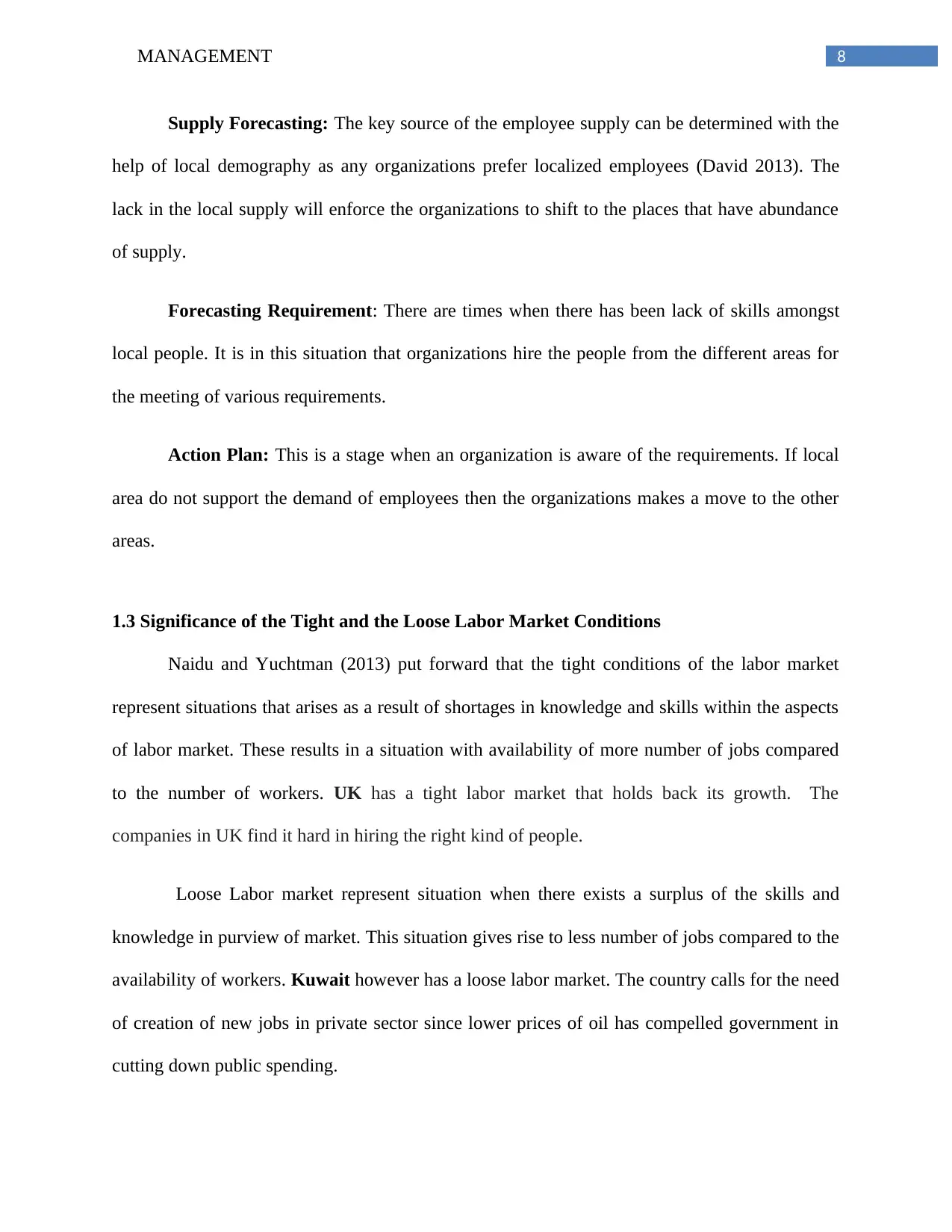
8MANAGEMENT
Supply Forecasting: The key source of the employee supply can be determined with the
help of local demography as any organizations prefer localized employees (David 2013). The
lack in the local supply will enforce the organizations to shift to the places that have abundance
of supply.
Forecasting Requirement: There are times when there has been lack of skills amongst
local people. It is in this situation that organizations hire the people from the different areas for
the meeting of various requirements.
Action Plan: This is a stage when an organization is aware of the requirements. If local
area do not support the demand of employees then the organizations makes a move to the other
areas.
1.3 Significance of the Tight and the Loose Labor Market Conditions
Naidu and Yuchtman (2013) put forward that the tight conditions of the labor market
represent situations that arises as a result of shortages in knowledge and skills within the aspects
of labor market. These results in a situation with availability of more number of jobs compared
to the number of workers. UK has a tight labor market that holds back its growth. The
companies in UK find it hard in hiring the right kind of people.
Loose Labor market represent situation when there exists a surplus of the skills and
knowledge in purview of market. This situation gives rise to less number of jobs compared to the
availability of workers. Kuwait however has a loose labor market. The country calls for the need
of creation of new jobs in private sector since lower prices of oil has compelled government in
cutting down public spending.
Supply Forecasting: The key source of the employee supply can be determined with the
help of local demography as any organizations prefer localized employees (David 2013). The
lack in the local supply will enforce the organizations to shift to the places that have abundance
of supply.
Forecasting Requirement: There are times when there has been lack of skills amongst
local people. It is in this situation that organizations hire the people from the different areas for
the meeting of various requirements.
Action Plan: This is a stage when an organization is aware of the requirements. If local
area do not support the demand of employees then the organizations makes a move to the other
areas.
1.3 Significance of the Tight and the Loose Labor Market Conditions
Naidu and Yuchtman (2013) put forward that the tight conditions of the labor market
represent situations that arises as a result of shortages in knowledge and skills within the aspects
of labor market. These results in a situation with availability of more number of jobs compared
to the number of workers. UK has a tight labor market that holds back its growth. The
companies in UK find it hard in hiring the right kind of people.
Loose Labor market represent situation when there exists a surplus of the skills and
knowledge in purview of market. This situation gives rise to less number of jobs compared to the
availability of workers. Kuwait however has a loose labor market. The country calls for the need
of creation of new jobs in private sector since lower prices of oil has compelled government in
cutting down public spending.
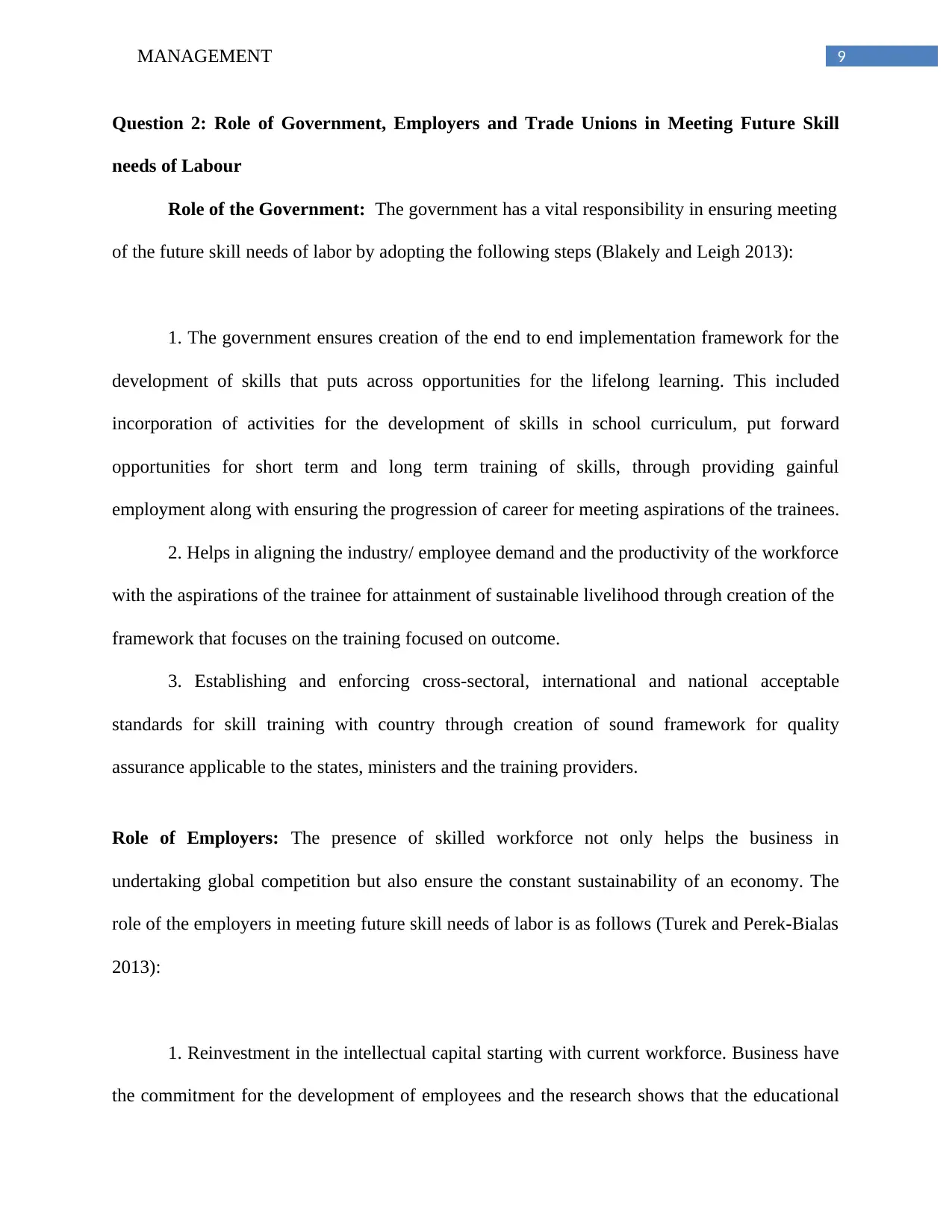
9MANAGEMENT
Question 2: Role of Government, Employers and Trade Unions in Meeting Future Skill
needs of Labour
Role of the Government: The government has a vital responsibility in ensuring meeting
of the future skill needs of labor by adopting the following steps (Blakely and Leigh 2013):
1. The government ensures creation of the end to end implementation framework for the
development of skills that puts across opportunities for the lifelong learning. This included
incorporation of activities for the development of skills in school curriculum, put forward
opportunities for short term and long term training of skills, through providing gainful
employment along with ensuring the progression of career for meeting aspirations of the trainees.
2. Helps in aligning the industry/ employee demand and the productivity of the workforce
with the aspirations of the trainee for attainment of sustainable livelihood through creation of the
framework that focuses on the training focused on outcome.
3. Establishing and enforcing cross-sectoral, international and national acceptable
standards for skill training with country through creation of sound framework for quality
assurance applicable to the states, ministers and the training providers.
Role of Employers: The presence of skilled workforce not only helps the business in
undertaking global competition but also ensure the constant sustainability of an economy. The
role of the employers in meeting future skill needs of labor is as follows (Turek and Perek-Bialas
2013):
1. Reinvestment in the intellectual capital starting with current workforce. Business have
the commitment for the development of employees and the research shows that the educational
Question 2: Role of Government, Employers and Trade Unions in Meeting Future Skill
needs of Labour
Role of the Government: The government has a vital responsibility in ensuring meeting
of the future skill needs of labor by adopting the following steps (Blakely and Leigh 2013):
1. The government ensures creation of the end to end implementation framework for the
development of skills that puts across opportunities for the lifelong learning. This included
incorporation of activities for the development of skills in school curriculum, put forward
opportunities for short term and long term training of skills, through providing gainful
employment along with ensuring the progression of career for meeting aspirations of the trainees.
2. Helps in aligning the industry/ employee demand and the productivity of the workforce
with the aspirations of the trainee for attainment of sustainable livelihood through creation of the
framework that focuses on the training focused on outcome.
3. Establishing and enforcing cross-sectoral, international and national acceptable
standards for skill training with country through creation of sound framework for quality
assurance applicable to the states, ministers and the training providers.
Role of Employers: The presence of skilled workforce not only helps the business in
undertaking global competition but also ensure the constant sustainability of an economy. The
role of the employers in meeting future skill needs of labor is as follows (Turek and Perek-Bialas
2013):
1. Reinvestment in the intellectual capital starting with current workforce. Business have
the commitment for the development of employees and the research shows that the educational
Secure Best Marks with AI Grader
Need help grading? Try our AI Grader for instant feedback on your assignments.
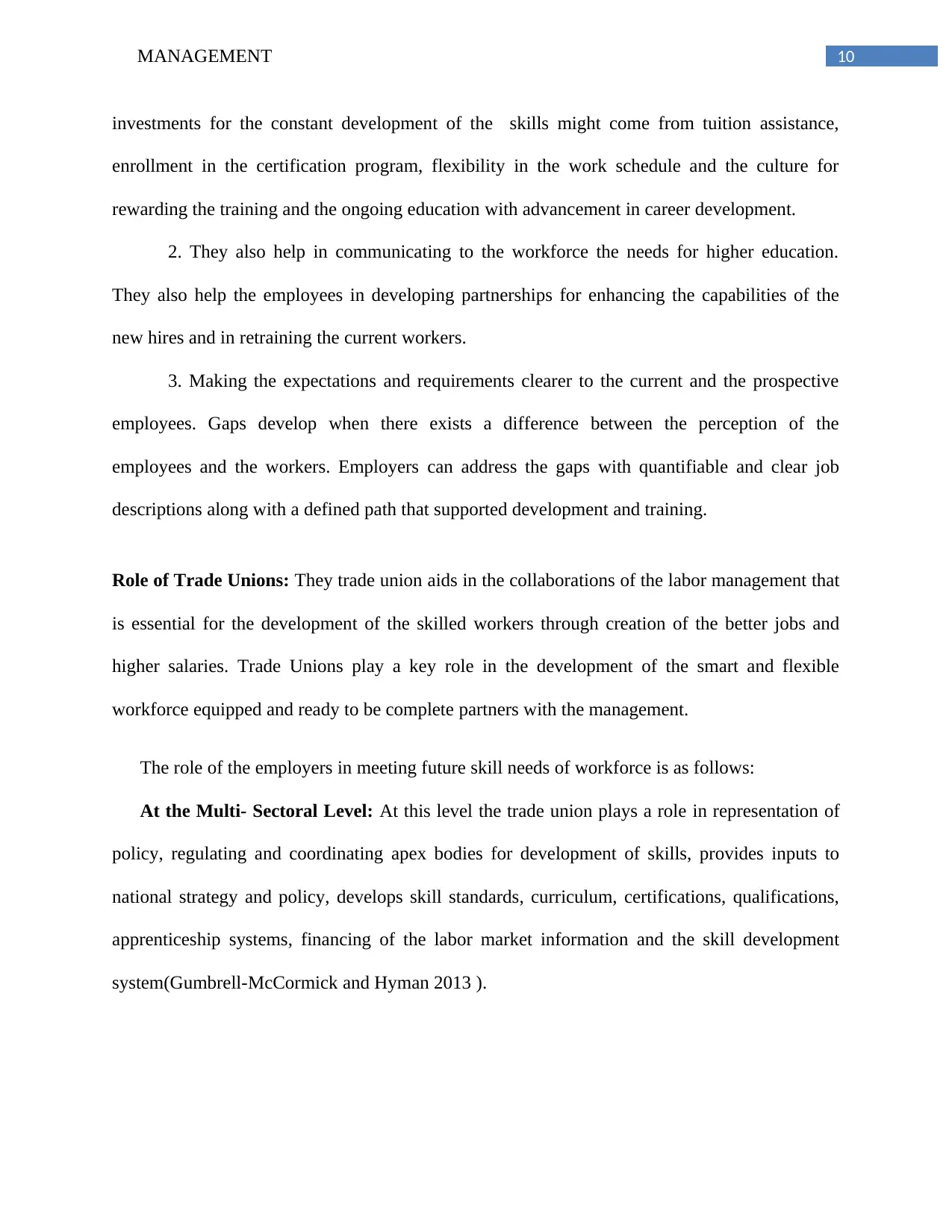
10MANAGEMENT
investments for the constant development of the skills might come from tuition assistance,
enrollment in the certification program, flexibility in the work schedule and the culture for
rewarding the training and the ongoing education with advancement in career development.
2. They also help in communicating to the workforce the needs for higher education.
They also help the employees in developing partnerships for enhancing the capabilities of the
new hires and in retraining the current workers.
3. Making the expectations and requirements clearer to the current and the prospective
employees. Gaps develop when there exists a difference between the perception of the
employees and the workers. Employers can address the gaps with quantifiable and clear job
descriptions along with a defined path that supported development and training.
Role of Trade Unions: They trade union aids in the collaborations of the labor management that
is essential for the development of the skilled workers through creation of the better jobs and
higher salaries. Trade Unions play a key role in the development of the smart and flexible
workforce equipped and ready to be complete partners with the management.
The role of the employers in meeting future skill needs of workforce is as follows:
At the Multi- Sectoral Level: At this level the trade union plays a role in representation of
policy, regulating and coordinating apex bodies for development of skills, provides inputs to
national strategy and policy, develops skill standards, curriculum, certifications, qualifications,
apprenticeship systems, financing of the labor market information and the skill development
system(Gumbrell-McCormick and Hyman 2013 ).
investments for the constant development of the skills might come from tuition assistance,
enrollment in the certification program, flexibility in the work schedule and the culture for
rewarding the training and the ongoing education with advancement in career development.
2. They also help in communicating to the workforce the needs for higher education.
They also help the employees in developing partnerships for enhancing the capabilities of the
new hires and in retraining the current workers.
3. Making the expectations and requirements clearer to the current and the prospective
employees. Gaps develop when there exists a difference between the perception of the
employees and the workers. Employers can address the gaps with quantifiable and clear job
descriptions along with a defined path that supported development and training.
Role of Trade Unions: They trade union aids in the collaborations of the labor management that
is essential for the development of the skilled workers through creation of the better jobs and
higher salaries. Trade Unions play a key role in the development of the smart and flexible
workforce equipped and ready to be complete partners with the management.
The role of the employers in meeting future skill needs of workforce is as follows:
At the Multi- Sectoral Level: At this level the trade union plays a role in representation of
policy, regulating and coordinating apex bodies for development of skills, provides inputs to
national strategy and policy, develops skill standards, curriculum, certifications, qualifications,
apprenticeship systems, financing of the labor market information and the skill development
system(Gumbrell-McCormick and Hyman 2013 ).
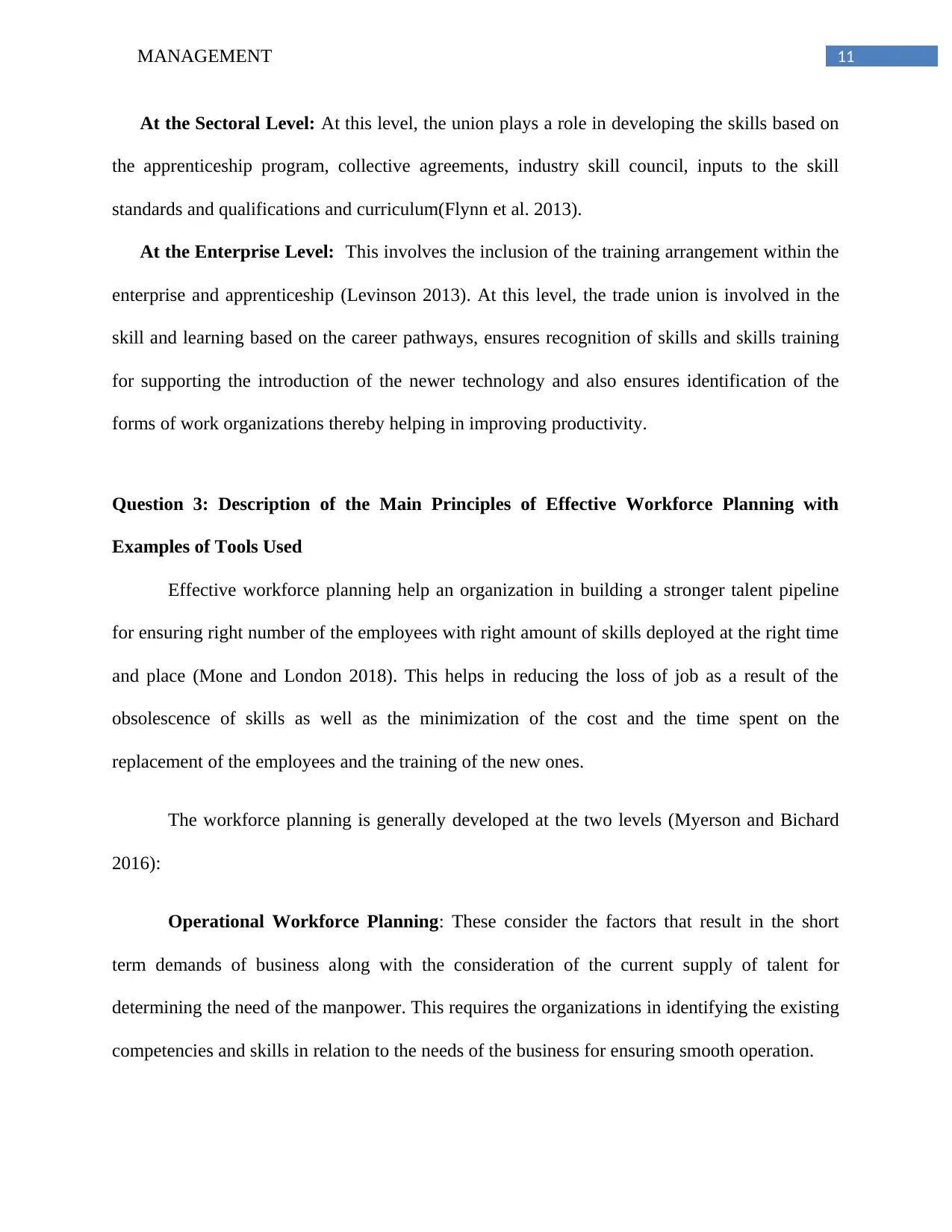
11MANAGEMENT
At the Sectoral Level: At this level, the union plays a role in developing the skills based on
the apprenticeship program, collective agreements, industry skill council, inputs to the skill
standards and qualifications and curriculum(Flynn et al. 2013).
At the Enterprise Level: This involves the inclusion of the training arrangement within the
enterprise and apprenticeship (Levinson 2013). At this level, the trade union is involved in the
skill and learning based on the career pathways, ensures recognition of skills and skills training
for supporting the introduction of the newer technology and also ensures identification of the
forms of work organizations thereby helping in improving productivity.
Question 3: Description of the Main Principles of Effective Workforce Planning with
Examples of Tools Used
Effective workforce planning help an organization in building a stronger talent pipeline
for ensuring right number of the employees with right amount of skills deployed at the right time
and place (Mone and London 2018). This helps in reducing the loss of job as a result of the
obsolescence of skills as well as the minimization of the cost and the time spent on the
replacement of the employees and the training of the new ones.
The workforce planning is generally developed at the two levels (Myerson and Bichard
2016):
Operational Workforce Planning: These consider the factors that result in the short
term demands of business along with the consideration of the current supply of talent for
determining the need of the manpower. This requires the organizations in identifying the existing
competencies and skills in relation to the needs of the business for ensuring smooth operation.
At the Sectoral Level: At this level, the union plays a role in developing the skills based on
the apprenticeship program, collective agreements, industry skill council, inputs to the skill
standards and qualifications and curriculum(Flynn et al. 2013).
At the Enterprise Level: This involves the inclusion of the training arrangement within the
enterprise and apprenticeship (Levinson 2013). At this level, the trade union is involved in the
skill and learning based on the career pathways, ensures recognition of skills and skills training
for supporting the introduction of the newer technology and also ensures identification of the
forms of work organizations thereby helping in improving productivity.
Question 3: Description of the Main Principles of Effective Workforce Planning with
Examples of Tools Used
Effective workforce planning help an organization in building a stronger talent pipeline
for ensuring right number of the employees with right amount of skills deployed at the right time
and place (Mone and London 2018). This helps in reducing the loss of job as a result of the
obsolescence of skills as well as the minimization of the cost and the time spent on the
replacement of the employees and the training of the new ones.
The workforce planning is generally developed at the two levels (Myerson and Bichard
2016):
Operational Workforce Planning: These consider the factors that result in the short
term demands of business along with the consideration of the current supply of talent for
determining the need of the manpower. This requires the organizations in identifying the existing
competencies and skills in relation to the needs of the business for ensuring smooth operation.
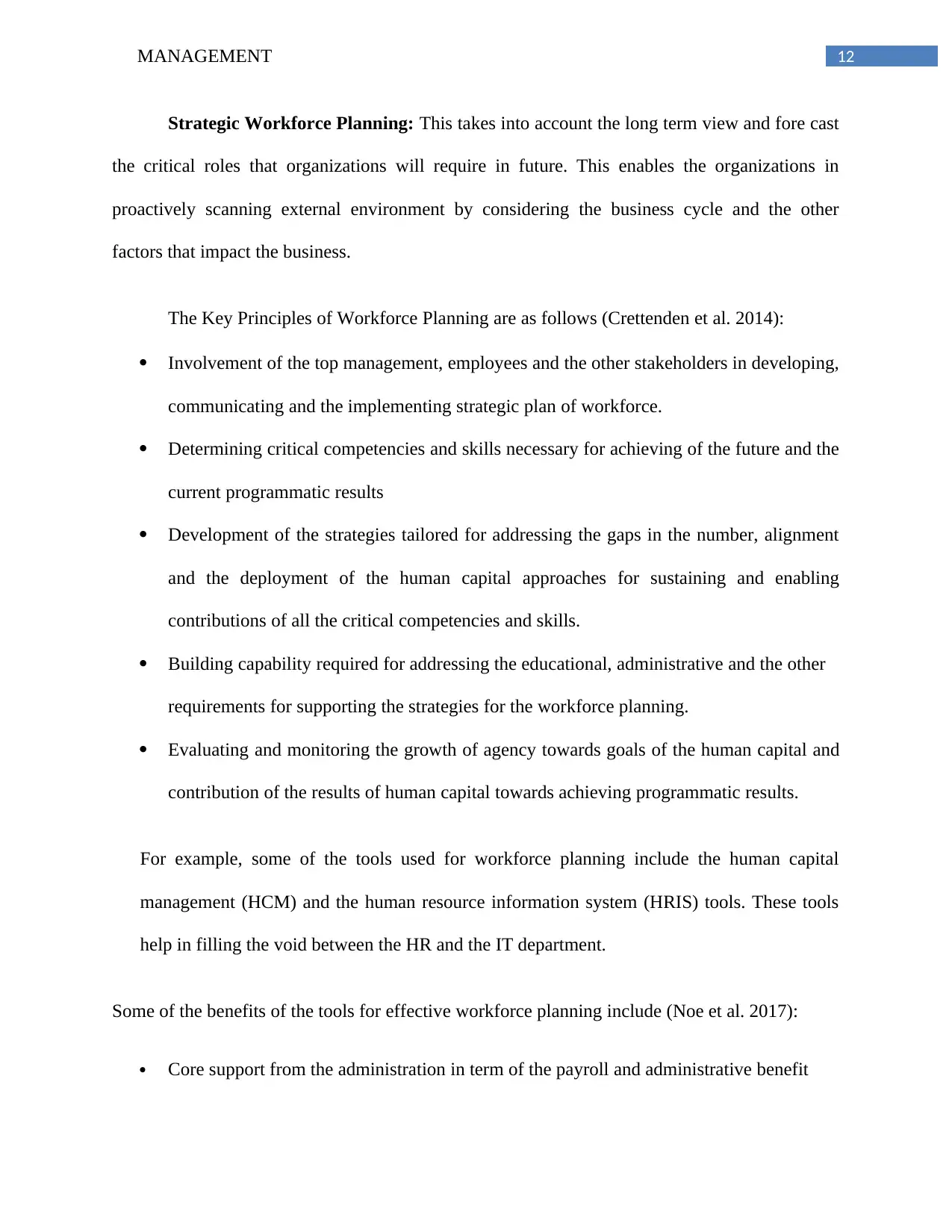
12MANAGEMENT
Strategic Workforce Planning: This takes into account the long term view and fore cast
the critical roles that organizations will require in future. This enables the organizations in
proactively scanning external environment by considering the business cycle and the other
factors that impact the business.
The Key Principles of Workforce Planning are as follows (Crettenden et al. 2014):
Involvement of the top management, employees and the other stakeholders in developing,
communicating and the implementing strategic plan of workforce.
Determining critical competencies and skills necessary for achieving of the future and the
current programmatic results
Development of the strategies tailored for addressing the gaps in the number, alignment
and the deployment of the human capital approaches for sustaining and enabling
contributions of all the critical competencies and skills.
Building capability required for addressing the educational, administrative and the other
requirements for supporting the strategies for the workforce planning.
Evaluating and monitoring the growth of agency towards goals of the human capital and
contribution of the results of human capital towards achieving programmatic results.
For example, some of the tools used for workforce planning include the human capital
management (HCM) and the human resource information system (HRIS) tools. These tools
help in filling the void between the HR and the IT department.
Some of the benefits of the tools for effective workforce planning include (Noe et al. 2017):
Core support from the administration in term of the payroll and administrative benefit
Strategic Workforce Planning: This takes into account the long term view and fore cast
the critical roles that organizations will require in future. This enables the organizations in
proactively scanning external environment by considering the business cycle and the other
factors that impact the business.
The Key Principles of Workforce Planning are as follows (Crettenden et al. 2014):
Involvement of the top management, employees and the other stakeholders in developing,
communicating and the implementing strategic plan of workforce.
Determining critical competencies and skills necessary for achieving of the future and the
current programmatic results
Development of the strategies tailored for addressing the gaps in the number, alignment
and the deployment of the human capital approaches for sustaining and enabling
contributions of all the critical competencies and skills.
Building capability required for addressing the educational, administrative and the other
requirements for supporting the strategies for the workforce planning.
Evaluating and monitoring the growth of agency towards goals of the human capital and
contribution of the results of human capital towards achieving programmatic results.
For example, some of the tools used for workforce planning include the human capital
management (HCM) and the human resource information system (HRIS) tools. These tools
help in filling the void between the HR and the IT department.
Some of the benefits of the tools for effective workforce planning include (Noe et al. 2017):
Core support from the administration in term of the payroll and administrative benefit
Paraphrase This Document
Need a fresh take? Get an instant paraphrase of this document with our AI Paraphraser
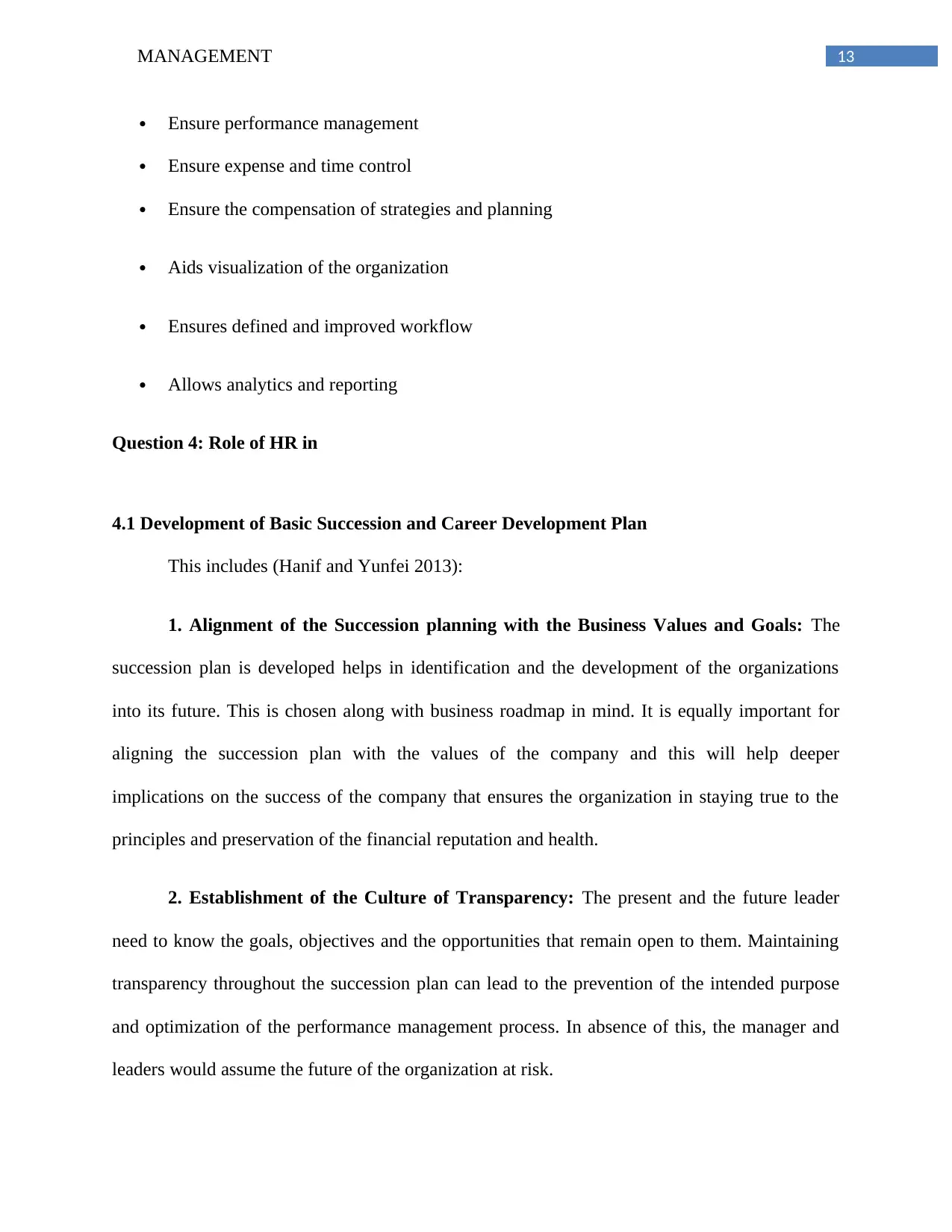
13MANAGEMENT
Ensure performance management
Ensure expense and time control
Ensure the compensation of strategies and planning
Aids visualization of the organization
Ensures defined and improved workflow
Allows analytics and reporting
Question 4: Role of HR in
4.1 Development of Basic Succession and Career Development Plan
This includes (Hanif and Yunfei 2013):
1. Alignment of the Succession planning with the Business Values and Goals: The
succession plan is developed helps in identification and the development of the organizations
into its future. This is chosen along with business roadmap in mind. It is equally important for
aligning the succession plan with the values of the company and this will help deeper
implications on the success of the company that ensures the organization in staying true to the
principles and preservation of the financial reputation and health.
2. Establishment of the Culture of Transparency: The present and the future leader
need to know the goals, objectives and the opportunities that remain open to them. Maintaining
transparency throughout the succession plan can lead to the prevention of the intended purpose
and optimization of the performance management process. In absence of this, the manager and
leaders would assume the future of the organization at risk.
Ensure performance management
Ensure expense and time control
Ensure the compensation of strategies and planning
Aids visualization of the organization
Ensures defined and improved workflow
Allows analytics and reporting
Question 4: Role of HR in
4.1 Development of Basic Succession and Career Development Plan
This includes (Hanif and Yunfei 2013):
1. Alignment of the Succession planning with the Business Values and Goals: The
succession plan is developed helps in identification and the development of the organizations
into its future. This is chosen along with business roadmap in mind. It is equally important for
aligning the succession plan with the values of the company and this will help deeper
implications on the success of the company that ensures the organization in staying true to the
principles and preservation of the financial reputation and health.
2. Establishment of the Culture of Transparency: The present and the future leader
need to know the goals, objectives and the opportunities that remain open to them. Maintaining
transparency throughout the succession plan can lead to the prevention of the intended purpose
and optimization of the performance management process. In absence of this, the manager and
leaders would assume the future of the organization at risk.
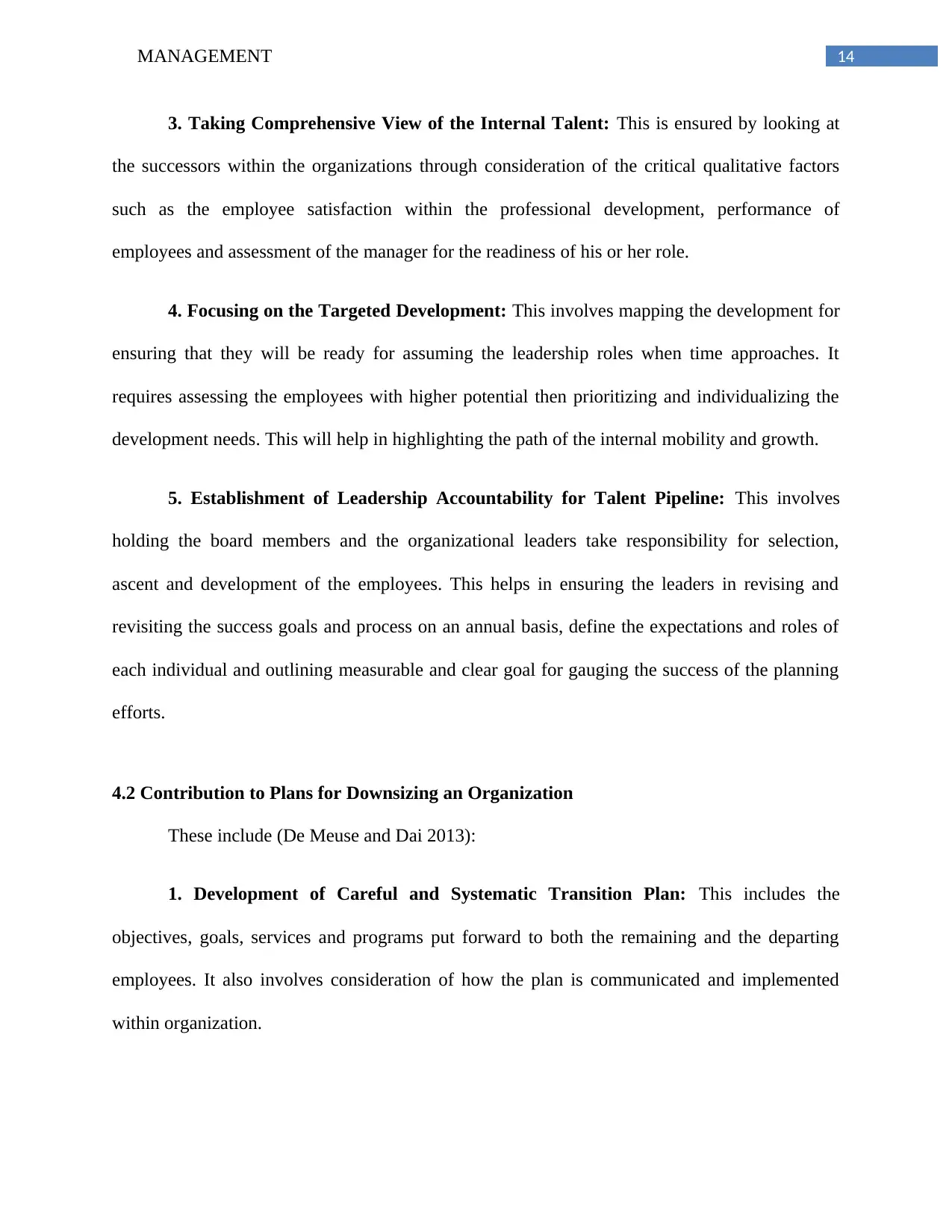
14MANAGEMENT
3. Taking Comprehensive View of the Internal Talent: This is ensured by looking at
the successors within the organizations through consideration of the critical qualitative factors
such as the employee satisfaction within the professional development, performance of
employees and assessment of the manager for the readiness of his or her role.
4. Focusing on the Targeted Development: This involves mapping the development for
ensuring that they will be ready for assuming the leadership roles when time approaches. It
requires assessing the employees with higher potential then prioritizing and individualizing the
development needs. This will help in highlighting the path of the internal mobility and growth.
5. Establishment of Leadership Accountability for Talent Pipeline: This involves
holding the board members and the organizational leaders take responsibility for selection,
ascent and development of the employees. This helps in ensuring the leaders in revising and
revisiting the success goals and process on an annual basis, define the expectations and roles of
each individual and outlining measurable and clear goal for gauging the success of the planning
efforts.
4.2 Contribution to Plans for Downsizing an Organization
These include (De Meuse and Dai 2013):
1. Development of Careful and Systematic Transition Plan: This includes the
objectives, goals, services and programs put forward to both the remaining and the departing
employees. It also involves consideration of how the plan is communicated and implemented
within organization.
3. Taking Comprehensive View of the Internal Talent: This is ensured by looking at
the successors within the organizations through consideration of the critical qualitative factors
such as the employee satisfaction within the professional development, performance of
employees and assessment of the manager for the readiness of his or her role.
4. Focusing on the Targeted Development: This involves mapping the development for
ensuring that they will be ready for assuming the leadership roles when time approaches. It
requires assessing the employees with higher potential then prioritizing and individualizing the
development needs. This will help in highlighting the path of the internal mobility and growth.
5. Establishment of Leadership Accountability for Talent Pipeline: This involves
holding the board members and the organizational leaders take responsibility for selection,
ascent and development of the employees. This helps in ensuring the leaders in revising and
revisiting the success goals and process on an annual basis, define the expectations and roles of
each individual and outlining measurable and clear goal for gauging the success of the planning
efforts.
4.2 Contribution to Plans for Downsizing an Organization
These include (De Meuse and Dai 2013):
1. Development of Careful and Systematic Transition Plan: This includes the
objectives, goals, services and programs put forward to both the remaining and the departing
employees. It also involves consideration of how the plan is communicated and implemented
within organization.
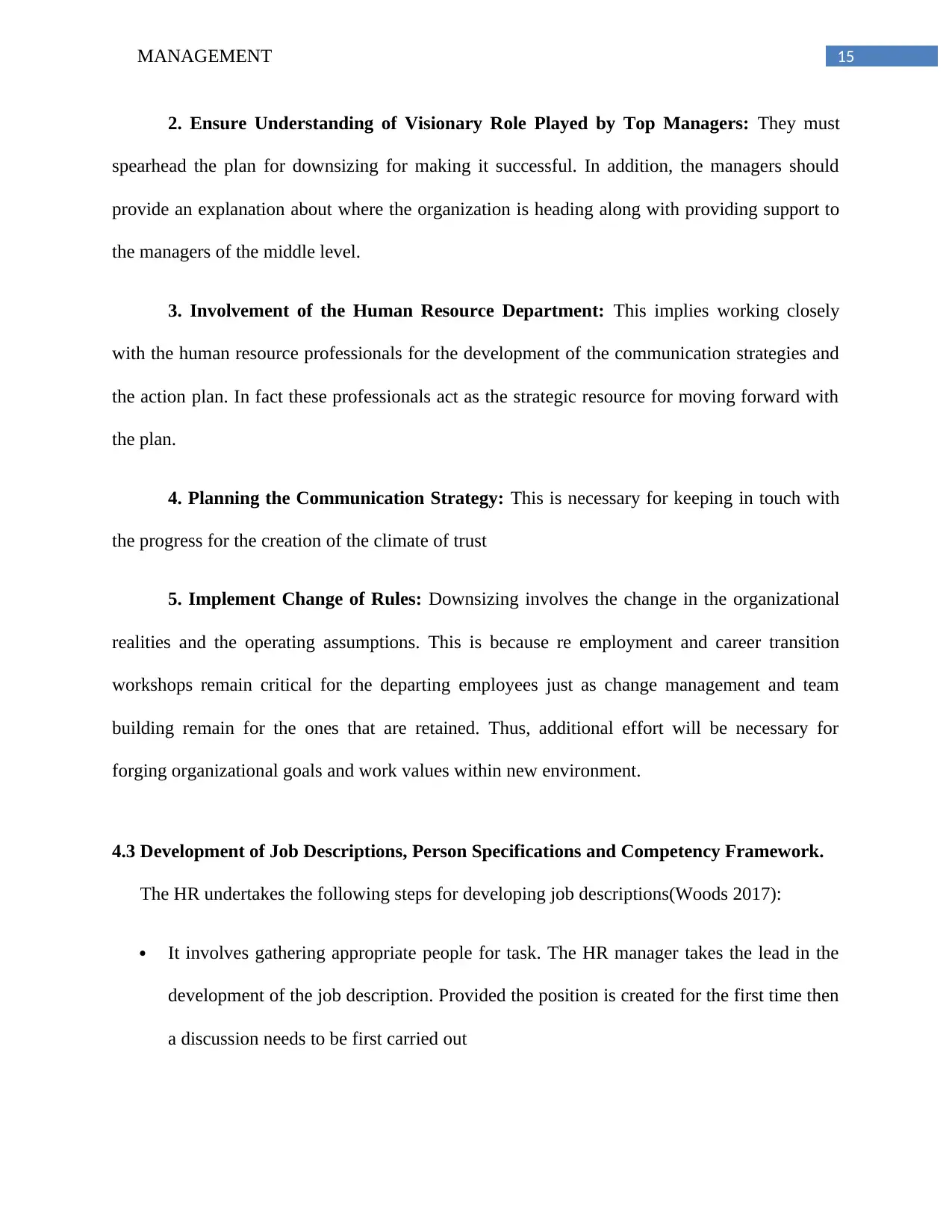
15MANAGEMENT
2. Ensure Understanding of Visionary Role Played by Top Managers: They must
spearhead the plan for downsizing for making it successful. In addition, the managers should
provide an explanation about where the organization is heading along with providing support to
the managers of the middle level.
3. Involvement of the Human Resource Department: This implies working closely
with the human resource professionals for the development of the communication strategies and
the action plan. In fact these professionals act as the strategic resource for moving forward with
the plan.
4. Planning the Communication Strategy: This is necessary for keeping in touch with
the progress for the creation of the climate of trust
5. Implement Change of Rules: Downsizing involves the change in the organizational
realities and the operating assumptions. This is because re employment and career transition
workshops remain critical for the departing employees just as change management and team
building remain for the ones that are retained. Thus, additional effort will be necessary for
forging organizational goals and work values within new environment.
4.3 Development of Job Descriptions, Person Specifications and Competency Framework.
The HR undertakes the following steps for developing job descriptions(Woods 2017):
It involves gathering appropriate people for task. The HR manager takes the lead in the
development of the job description. Provided the position is created for the first time then
a discussion needs to be first carried out
2. Ensure Understanding of Visionary Role Played by Top Managers: They must
spearhead the plan for downsizing for making it successful. In addition, the managers should
provide an explanation about where the organization is heading along with providing support to
the managers of the middle level.
3. Involvement of the Human Resource Department: This implies working closely
with the human resource professionals for the development of the communication strategies and
the action plan. In fact these professionals act as the strategic resource for moving forward with
the plan.
4. Planning the Communication Strategy: This is necessary for keeping in touch with
the progress for the creation of the climate of trust
5. Implement Change of Rules: Downsizing involves the change in the organizational
realities and the operating assumptions. This is because re employment and career transition
workshops remain critical for the departing employees just as change management and team
building remain for the ones that are retained. Thus, additional effort will be necessary for
forging organizational goals and work values within new environment.
4.3 Development of Job Descriptions, Person Specifications and Competency Framework.
The HR undertakes the following steps for developing job descriptions(Woods 2017):
It involves gathering appropriate people for task. The HR manager takes the lead in the
development of the job description. Provided the position is created for the first time then
a discussion needs to be first carried out
Secure Best Marks with AI Grader
Need help grading? Try our AI Grader for instant feedback on your assignments.
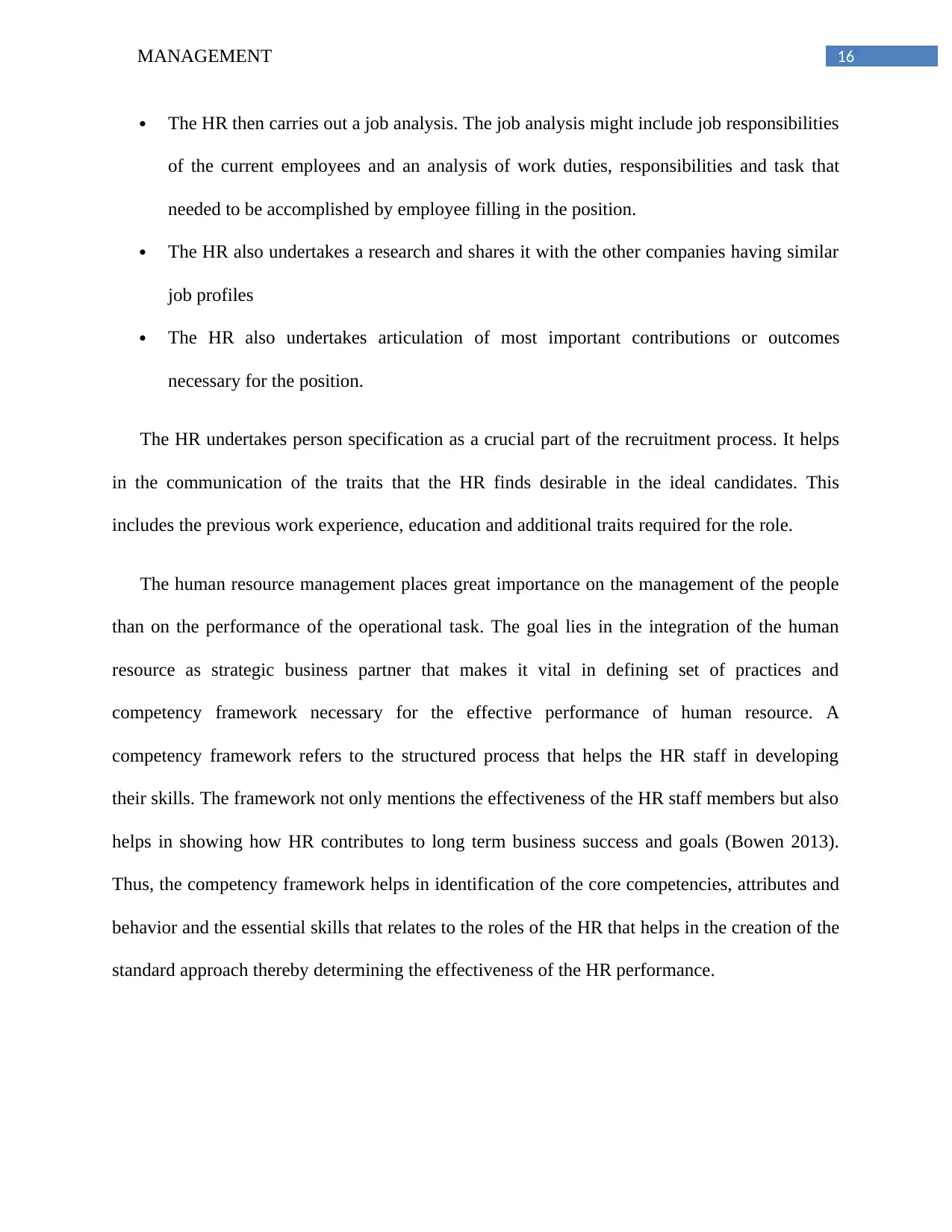
16MANAGEMENT
The HR then carries out a job analysis. The job analysis might include job responsibilities
of the current employees and an analysis of work duties, responsibilities and task that
needed to be accomplished by employee filling in the position.
The HR also undertakes a research and shares it with the other companies having similar
job profiles
The HR also undertakes articulation of most important contributions or outcomes
necessary for the position.
The HR undertakes person specification as a crucial part of the recruitment process. It helps
in the communication of the traits that the HR finds desirable in the ideal candidates. This
includes the previous work experience, education and additional traits required for the role.
The human resource management places great importance on the management of the people
than on the performance of the operational task. The goal lies in the integration of the human
resource as strategic business partner that makes it vital in defining set of practices and
competency framework necessary for the effective performance of human resource. A
competency framework refers to the structured process that helps the HR staff in developing
their skills. The framework not only mentions the effectiveness of the HR staff members but also
helps in showing how HR contributes to long term business success and goals (Bowen 2013).
Thus, the competency framework helps in identification of the core competencies, attributes and
behavior and the essential skills that relates to the roles of the HR that helps in the creation of the
standard approach thereby determining the effectiveness of the HR performance.
The HR then carries out a job analysis. The job analysis might include job responsibilities
of the current employees and an analysis of work duties, responsibilities and task that
needed to be accomplished by employee filling in the position.
The HR also undertakes a research and shares it with the other companies having similar
job profiles
The HR also undertakes articulation of most important contributions or outcomes
necessary for the position.
The HR undertakes person specification as a crucial part of the recruitment process. It helps
in the communication of the traits that the HR finds desirable in the ideal candidates. This
includes the previous work experience, education and additional traits required for the role.
The human resource management places great importance on the management of the people
than on the performance of the operational task. The goal lies in the integration of the human
resource as strategic business partner that makes it vital in defining set of practices and
competency framework necessary for the effective performance of human resource. A
competency framework refers to the structured process that helps the HR staff in developing
their skills. The framework not only mentions the effectiveness of the HR staff members but also
helps in showing how HR contributes to long term business success and goals (Bowen 2013).
Thus, the competency framework helps in identification of the core competencies, attributes and
behavior and the essential skills that relates to the roles of the HR that helps in the creation of the
standard approach thereby determining the effectiveness of the HR performance.
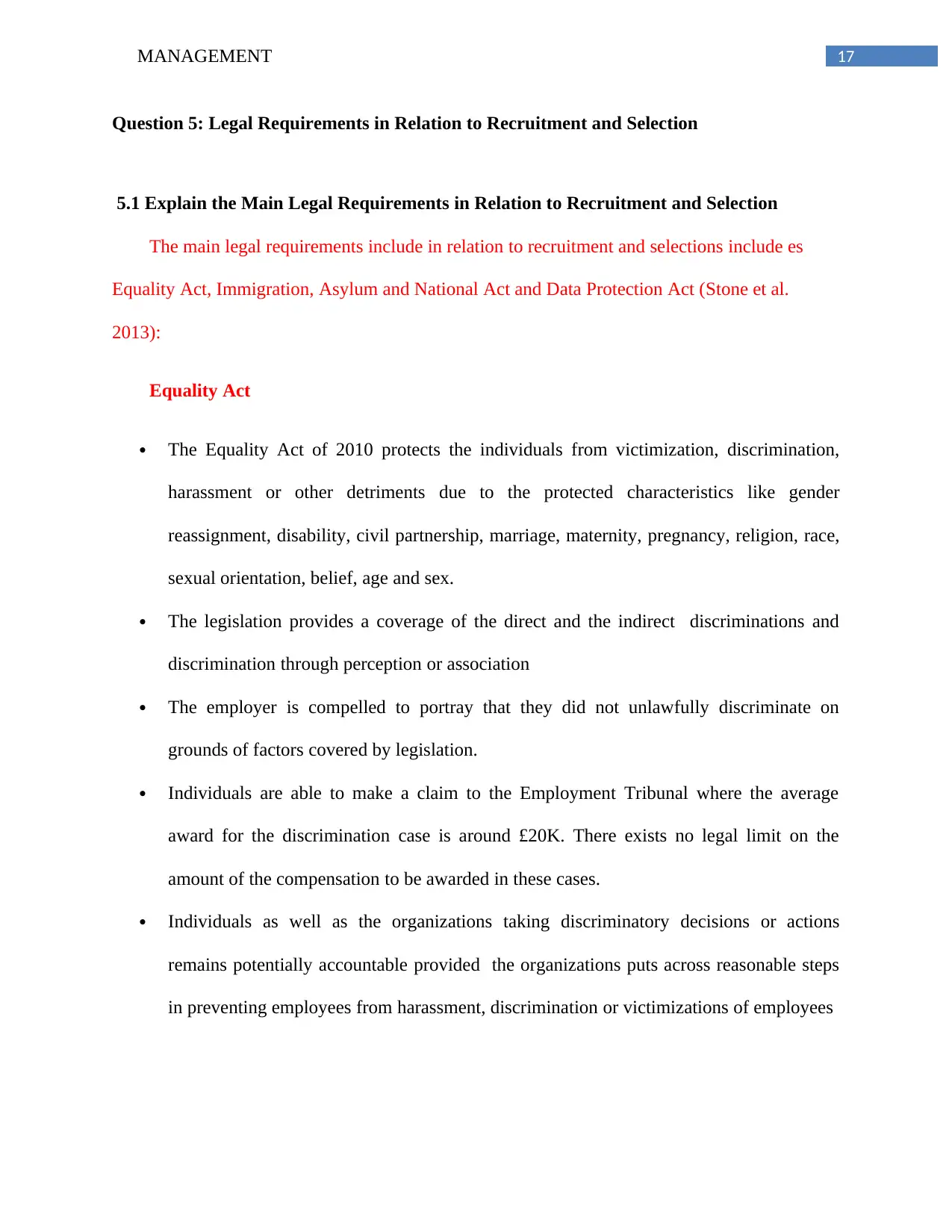
17MANAGEMENT
Question 5: Legal Requirements in Relation to Recruitment and Selection
5.1 Explain the Main Legal Requirements in Relation to Recruitment and Selection
The main legal requirements include in relation to recruitment and selections include es
Equality Act, Immigration, Asylum and National Act and Data Protection Act (Stone et al.
2013):
Equality Act
The Equality Act of 2010 protects the individuals from victimization, discrimination,
harassment or other detriments due to the protected characteristics like gender
reassignment, disability, civil partnership, marriage, maternity, pregnancy, religion, race,
sexual orientation, belief, age and sex.
The legislation provides a coverage of the direct and the indirect discriminations and
discrimination through perception or association
The employer is compelled to portray that they did not unlawfully discriminate on
grounds of factors covered by legislation.
Individuals are able to make a claim to the Employment Tribunal where the average
award for the discrimination case is around £20K. There exists no legal limit on the
amount of the compensation to be awarded in these cases.
Individuals as well as the organizations taking discriminatory decisions or actions
remains potentially accountable provided the organizations puts across reasonable steps
in preventing employees from harassment, discrimination or victimizations of employees
Question 5: Legal Requirements in Relation to Recruitment and Selection
5.1 Explain the Main Legal Requirements in Relation to Recruitment and Selection
The main legal requirements include in relation to recruitment and selections include es
Equality Act, Immigration, Asylum and National Act and Data Protection Act (Stone et al.
2013):
Equality Act
The Equality Act of 2010 protects the individuals from victimization, discrimination,
harassment or other detriments due to the protected characteristics like gender
reassignment, disability, civil partnership, marriage, maternity, pregnancy, religion, race,
sexual orientation, belief, age and sex.
The legislation provides a coverage of the direct and the indirect discriminations and
discrimination through perception or association
The employer is compelled to portray that they did not unlawfully discriminate on
grounds of factors covered by legislation.
Individuals are able to make a claim to the Employment Tribunal where the average
award for the discrimination case is around £20K. There exists no legal limit on the
amount of the compensation to be awarded in these cases.
Individuals as well as the organizations taking discriminatory decisions or actions
remains potentially accountable provided the organizations puts across reasonable steps
in preventing employees from harassment, discrimination or victimizations of employees
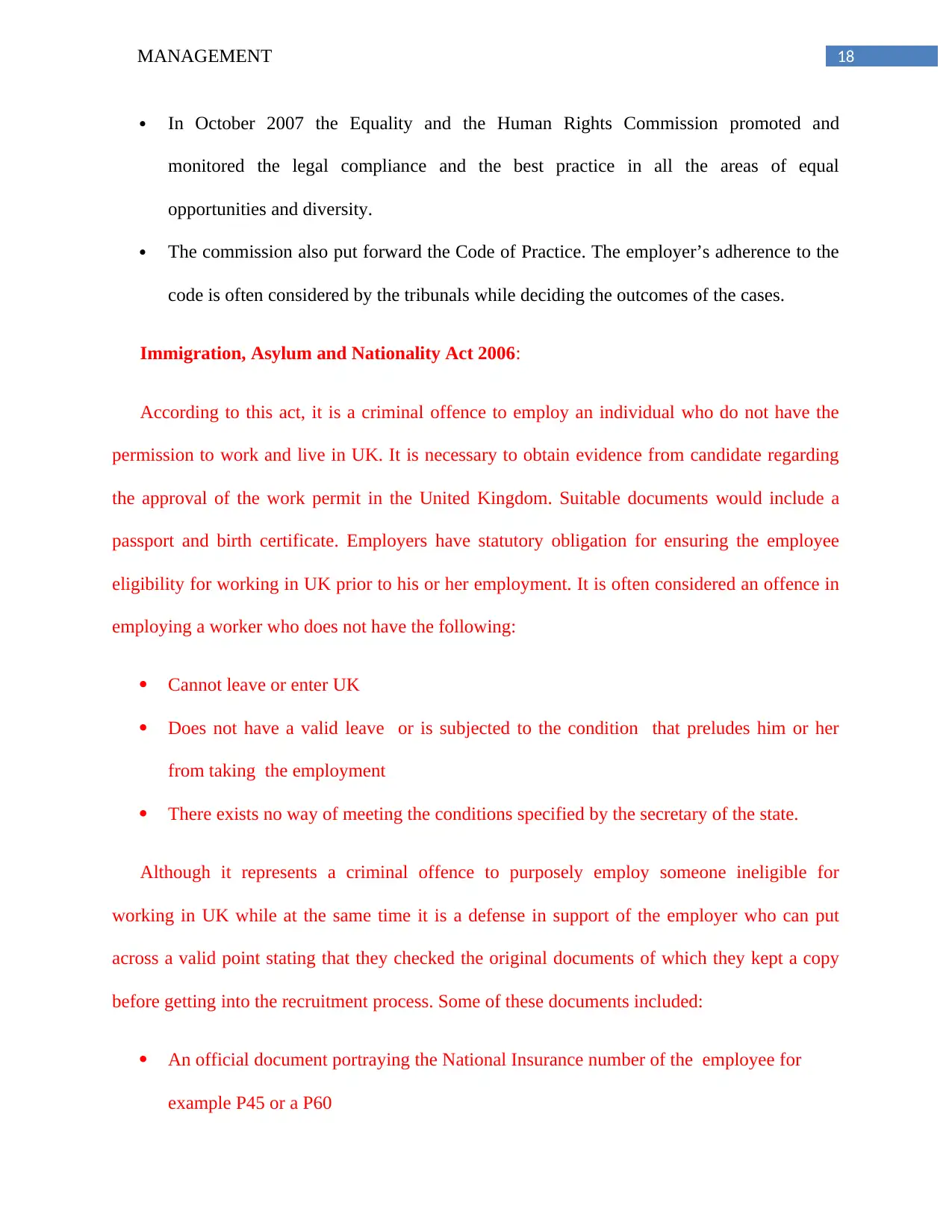
18MANAGEMENT
In October 2007 the Equality and the Human Rights Commission promoted and
monitored the legal compliance and the best practice in all the areas of equal
opportunities and diversity.
The commission also put forward the Code of Practice. The employer’s adherence to the
code is often considered by the tribunals while deciding the outcomes of the cases.
Immigration, Asylum and Nationality Act 2006:
According to this act, it is a criminal offence to employ an individual who do not have the
permission to work and live in UK. It is necessary to obtain evidence from candidate regarding
the approval of the work permit in the United Kingdom. Suitable documents would include a
passport and birth certificate. Employers have statutory obligation for ensuring the employee
eligibility for working in UK prior to his or her employment. It is often considered an offence in
employing a worker who does not have the following:
Cannot leave or enter UK
Does not have a valid leave or is subjected to the condition that preludes him or her
from taking the employment
There exists no way of meeting the conditions specified by the secretary of the state.
Although it represents a criminal offence to purposely employ someone ineligible for
working in UK while at the same time it is a defense in support of the employer who can put
across a valid point stating that they checked the original documents of which they kept a copy
before getting into the recruitment process. Some of these documents included:
An official document portraying the National Insurance number of the employee for
example P45 or a P60
In October 2007 the Equality and the Human Rights Commission promoted and
monitored the legal compliance and the best practice in all the areas of equal
opportunities and diversity.
The commission also put forward the Code of Practice. The employer’s adherence to the
code is often considered by the tribunals while deciding the outcomes of the cases.
Immigration, Asylum and Nationality Act 2006:
According to this act, it is a criminal offence to employ an individual who do not have the
permission to work and live in UK. It is necessary to obtain evidence from candidate regarding
the approval of the work permit in the United Kingdom. Suitable documents would include a
passport and birth certificate. Employers have statutory obligation for ensuring the employee
eligibility for working in UK prior to his or her employment. It is often considered an offence in
employing a worker who does not have the following:
Cannot leave or enter UK
Does not have a valid leave or is subjected to the condition that preludes him or her
from taking the employment
There exists no way of meeting the conditions specified by the secretary of the state.
Although it represents a criminal offence to purposely employ someone ineligible for
working in UK while at the same time it is a defense in support of the employer who can put
across a valid point stating that they checked the original documents of which they kept a copy
before getting into the recruitment process. Some of these documents included:
An official document portraying the National Insurance number of the employee for
example P45 or a P60
Paraphrase This Document
Need a fresh take? Get an instant paraphrase of this document with our AI Paraphraser
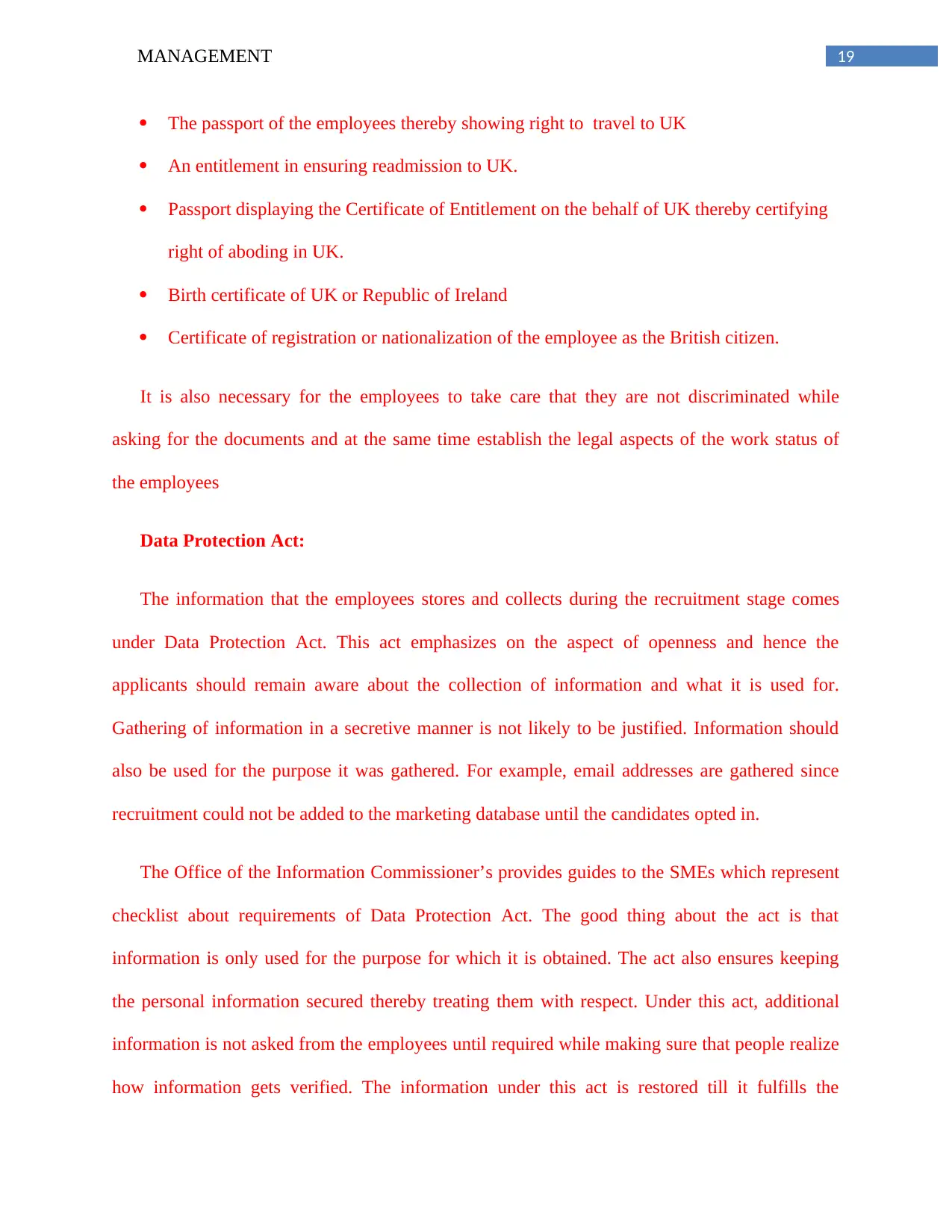
19MANAGEMENT
The passport of the employees thereby showing right to travel to UK
An entitlement in ensuring readmission to UK.
Passport displaying the Certificate of Entitlement on the behalf of UK thereby certifying
right of aboding in UK.
Birth certificate of UK or Republic of Ireland
Certificate of registration or nationalization of the employee as the British citizen.
It is also necessary for the employees to take care that they are not discriminated while
asking for the documents and at the same time establish the legal aspects of the work status of
the employees
Data Protection Act:
The information that the employees stores and collects during the recruitment stage comes
under Data Protection Act. This act emphasizes on the aspect of openness and hence the
applicants should remain aware about the collection of information and what it is used for.
Gathering of information in a secretive manner is not likely to be justified. Information should
also be used for the purpose it was gathered. For example, email addresses are gathered since
recruitment could not be added to the marketing database until the candidates opted in.
The Office of the Information Commissioner’s provides guides to the SMEs which represent
checklist about requirements of Data Protection Act. The good thing about the act is that
information is only used for the purpose for which it is obtained. The act also ensures keeping
the personal information secured thereby treating them with respect. Under this act, additional
information is not asked from the employees until required while making sure that people realize
how information gets verified. The information under this act is restored till it fulfills the
The passport of the employees thereby showing right to travel to UK
An entitlement in ensuring readmission to UK.
Passport displaying the Certificate of Entitlement on the behalf of UK thereby certifying
right of aboding in UK.
Birth certificate of UK or Republic of Ireland
Certificate of registration or nationalization of the employee as the British citizen.
It is also necessary for the employees to take care that they are not discriminated while
asking for the documents and at the same time establish the legal aspects of the work status of
the employees
Data Protection Act:
The information that the employees stores and collects during the recruitment stage comes
under Data Protection Act. This act emphasizes on the aspect of openness and hence the
applicants should remain aware about the collection of information and what it is used for.
Gathering of information in a secretive manner is not likely to be justified. Information should
also be used for the purpose it was gathered. For example, email addresses are gathered since
recruitment could not be added to the marketing database until the candidates opted in.
The Office of the Information Commissioner’s provides guides to the SMEs which represent
checklist about requirements of Data Protection Act. The good thing about the act is that
information is only used for the purpose for which it is obtained. The act also ensures keeping
the personal information secured thereby treating them with respect. Under this act, additional
information is not asked from the employees until required while making sure that people realize
how information gets verified. The information under this act is restored till it fulfills the
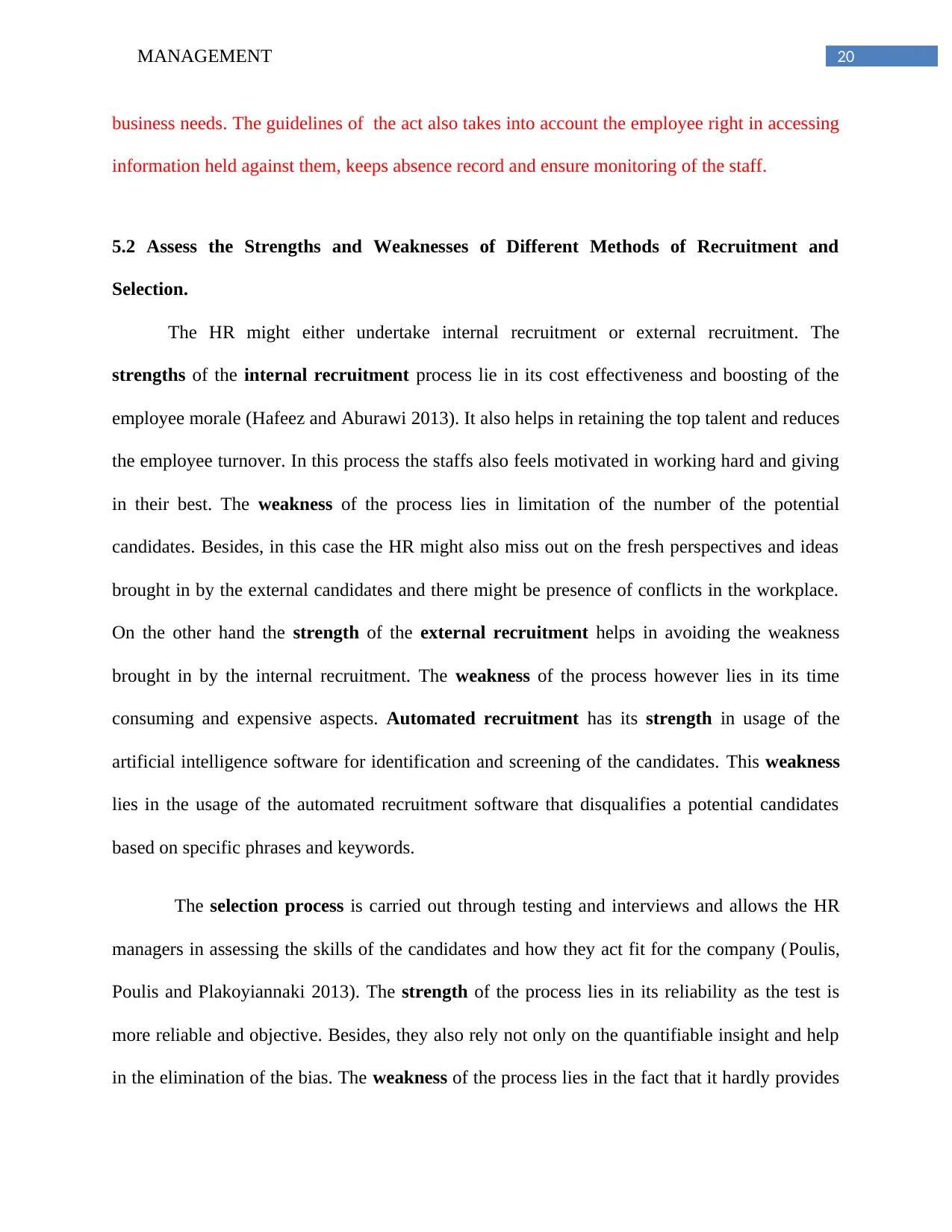
20MANAGEMENT
business needs. The guidelines of the act also takes into account the employee right in accessing
information held against them, keeps absence record and ensure monitoring of the staff.
5.2 Assess the Strengths and Weaknesses of Different Methods of Recruitment and
Selection.
The HR might either undertake internal recruitment or external recruitment. The
strengths of the internal recruitment process lie in its cost effectiveness and boosting of the
employee morale (Hafeez and Aburawi 2013). It also helps in retaining the top talent and reduces
the employee turnover. In this process the staffs also feels motivated in working hard and giving
in their best. The weakness of the process lies in limitation of the number of the potential
candidates. Besides, in this case the HR might also miss out on the fresh perspectives and ideas
brought in by the external candidates and there might be presence of conflicts in the workplace.
On the other hand the strength of the external recruitment helps in avoiding the weakness
brought in by the internal recruitment. The weakness of the process however lies in its time
consuming and expensive aspects. Automated recruitment has its strength in usage of the
artificial intelligence software for identification and screening of the candidates. This weakness
lies in the usage of the automated recruitment software that disqualifies a potential candidates
based on specific phrases and keywords.
The selection process is carried out through testing and interviews and allows the HR
managers in assessing the skills of the candidates and how they act fit for the company (Poulis,
Poulis and Plakoyiannaki 2013). The strength of the process lies in its reliability as the test is
more reliable and objective. Besides, they also rely not only on the quantifiable insight and help
in the elimination of the bias. The weakness of the process lies in the fact that it hardly provides
business needs. The guidelines of the act also takes into account the employee right in accessing
information held against them, keeps absence record and ensure monitoring of the staff.
5.2 Assess the Strengths and Weaknesses of Different Methods of Recruitment and
Selection.
The HR might either undertake internal recruitment or external recruitment. The
strengths of the internal recruitment process lie in its cost effectiveness and boosting of the
employee morale (Hafeez and Aburawi 2013). It also helps in retaining the top talent and reduces
the employee turnover. In this process the staffs also feels motivated in working hard and giving
in their best. The weakness of the process lies in limitation of the number of the potential
candidates. Besides, in this case the HR might also miss out on the fresh perspectives and ideas
brought in by the external candidates and there might be presence of conflicts in the workplace.
On the other hand the strength of the external recruitment helps in avoiding the weakness
brought in by the internal recruitment. The weakness of the process however lies in its time
consuming and expensive aspects. Automated recruitment has its strength in usage of the
artificial intelligence software for identification and screening of the candidates. This weakness
lies in the usage of the automated recruitment software that disqualifies a potential candidates
based on specific phrases and keywords.
The selection process is carried out through testing and interviews and allows the HR
managers in assessing the skills of the candidates and how they act fit for the company (Poulis,
Poulis and Plakoyiannaki 2013). The strength of the process lies in its reliability as the test is
more reliable and objective. Besides, they also rely not only on the quantifiable insight and help
in the elimination of the bias. The weakness of the process lies in the fact that it hardly provides
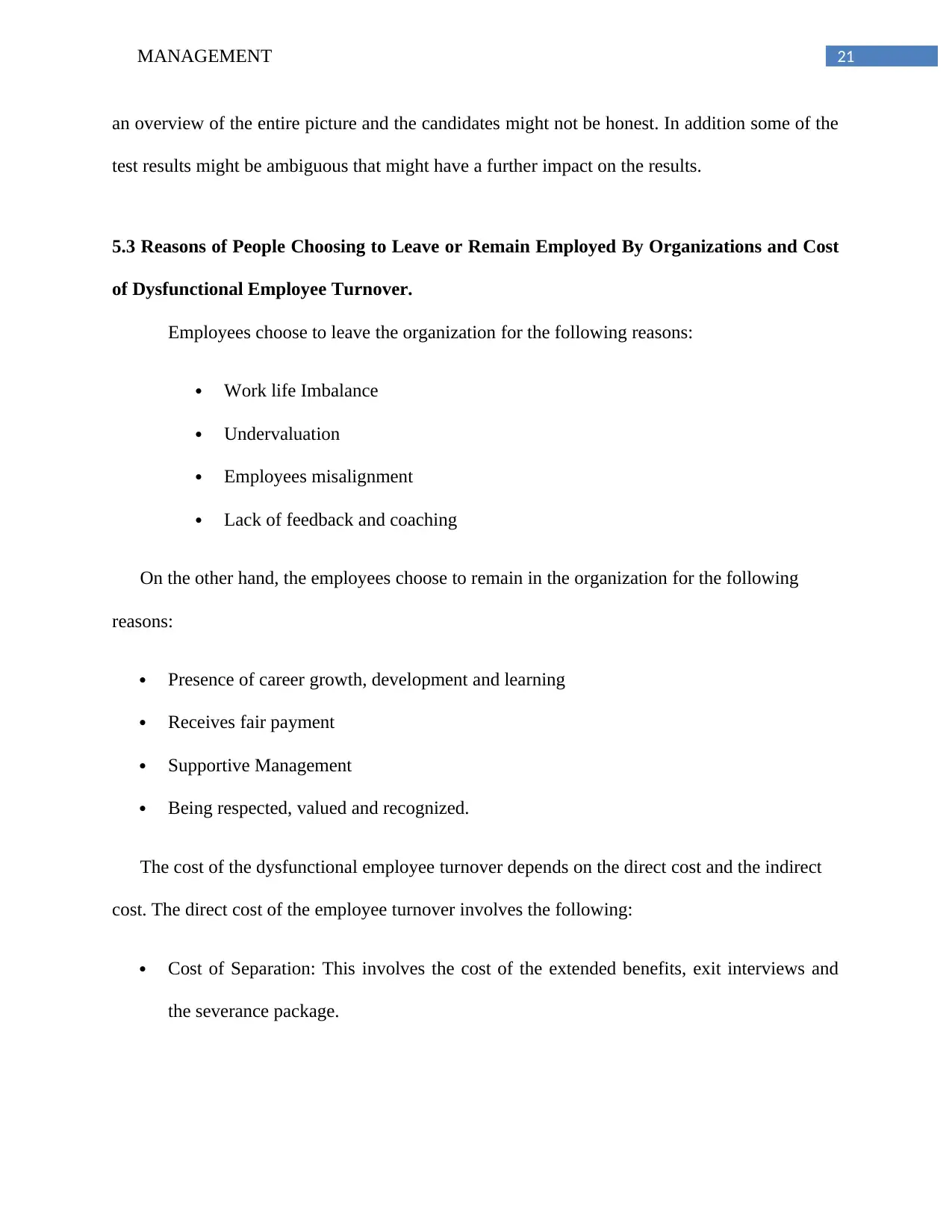
21MANAGEMENT
an overview of the entire picture and the candidates might not be honest. In addition some of the
test results might be ambiguous that might have a further impact on the results.
5.3 Reasons of People Choosing to Leave or Remain Employed By Organizations and Cost
of Dysfunctional Employee Turnover.
Employees choose to leave the organization for the following reasons:
Work life Imbalance
Undervaluation
Employees misalignment
Lack of feedback and coaching
On the other hand, the employees choose to remain in the organization for the following
reasons:
Presence of career growth, development and learning
Receives fair payment
Supportive Management
Being respected, valued and recognized.
The cost of the dysfunctional employee turnover depends on the direct cost and the indirect
cost. The direct cost of the employee turnover involves the following:
Cost of Separation: This involves the cost of the extended benefits, exit interviews and
the severance package.
an overview of the entire picture and the candidates might not be honest. In addition some of the
test results might be ambiguous that might have a further impact on the results.
5.3 Reasons of People Choosing to Leave or Remain Employed By Organizations and Cost
of Dysfunctional Employee Turnover.
Employees choose to leave the organization for the following reasons:
Work life Imbalance
Undervaluation
Employees misalignment
Lack of feedback and coaching
On the other hand, the employees choose to remain in the organization for the following
reasons:
Presence of career growth, development and learning
Receives fair payment
Supportive Management
Being respected, valued and recognized.
The cost of the dysfunctional employee turnover depends on the direct cost and the indirect
cost. The direct cost of the employee turnover involves the following:
Cost of Separation: This involves the cost of the extended benefits, exit interviews and
the severance package.
Secure Best Marks with AI Grader
Need help grading? Try our AI Grader for instant feedback on your assignments.
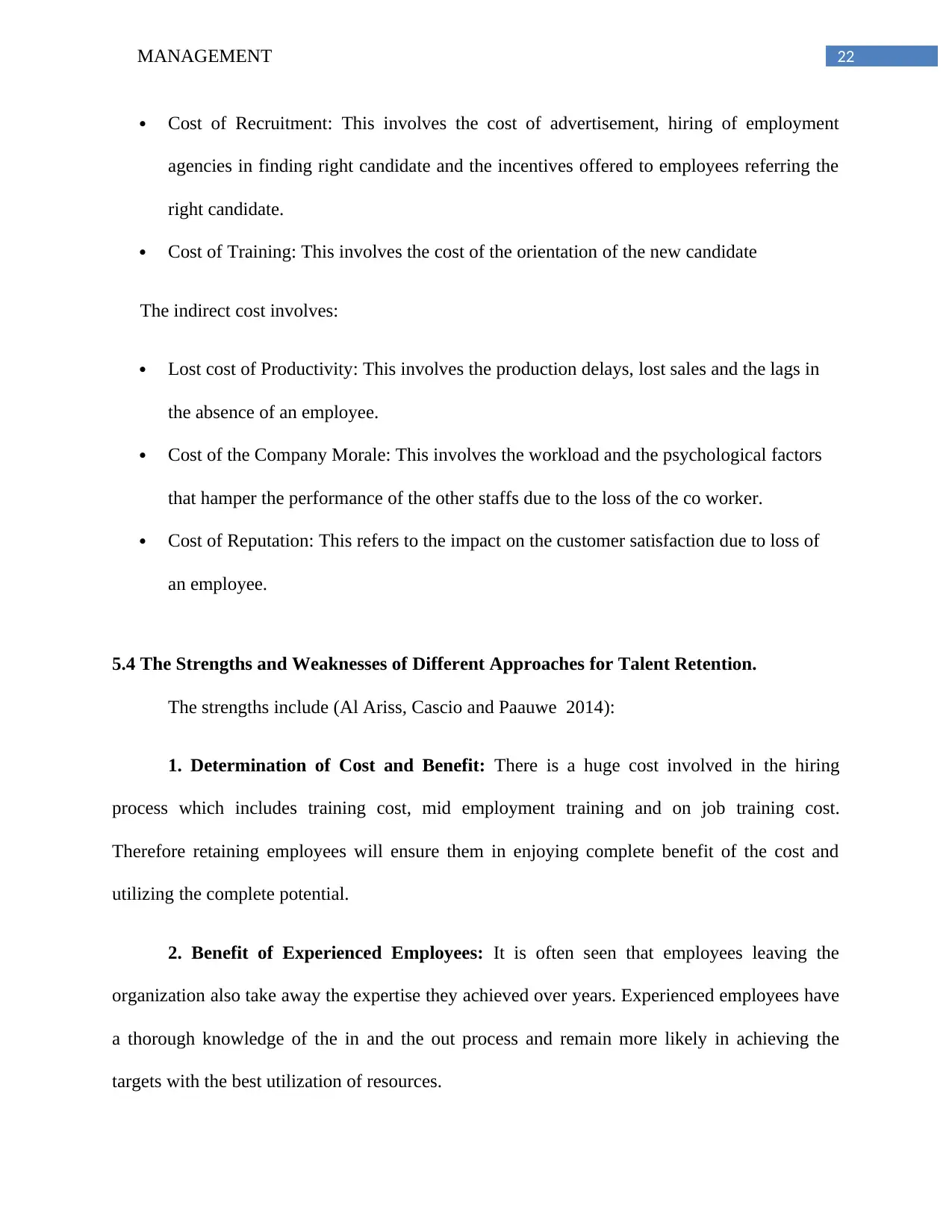
22MANAGEMENT
Cost of Recruitment: This involves the cost of advertisement, hiring of employment
agencies in finding right candidate and the incentives offered to employees referring the
right candidate.
Cost of Training: This involves the cost of the orientation of the new candidate
The indirect cost involves:
Lost cost of Productivity: This involves the production delays, lost sales and the lags in
the absence of an employee.
Cost of the Company Morale: This involves the workload and the psychological factors
that hamper the performance of the other staffs due to the loss of the co worker.
Cost of Reputation: This refers to the impact on the customer satisfaction due to loss of
an employee.
5.4 The Strengths and Weaknesses of Different Approaches for Talent Retention.
The strengths include (Al Ariss, Cascio and Paauwe 2014):
1. Determination of Cost and Benefit: There is a huge cost involved in the hiring
process which includes training cost, mid employment training and on job training cost.
Therefore retaining employees will ensure them in enjoying complete benefit of the cost and
utilizing the complete potential.
2. Benefit of Experienced Employees: It is often seen that employees leaving the
organization also take away the expertise they achieved over years. Experienced employees have
a thorough knowledge of the in and the out process and remain more likely in achieving the
targets with the best utilization of resources.
Cost of Recruitment: This involves the cost of advertisement, hiring of employment
agencies in finding right candidate and the incentives offered to employees referring the
right candidate.
Cost of Training: This involves the cost of the orientation of the new candidate
The indirect cost involves:
Lost cost of Productivity: This involves the production delays, lost sales and the lags in
the absence of an employee.
Cost of the Company Morale: This involves the workload and the psychological factors
that hamper the performance of the other staffs due to the loss of the co worker.
Cost of Reputation: This refers to the impact on the customer satisfaction due to loss of
an employee.
5.4 The Strengths and Weaknesses of Different Approaches for Talent Retention.
The strengths include (Al Ariss, Cascio and Paauwe 2014):
1. Determination of Cost and Benefit: There is a huge cost involved in the hiring
process which includes training cost, mid employment training and on job training cost.
Therefore retaining employees will ensure them in enjoying complete benefit of the cost and
utilizing the complete potential.
2. Benefit of Experienced Employees: It is often seen that employees leaving the
organization also take away the expertise they achieved over years. Experienced employees have
a thorough knowledge of the in and the out process and remain more likely in achieving the
targets with the best utilization of resources.
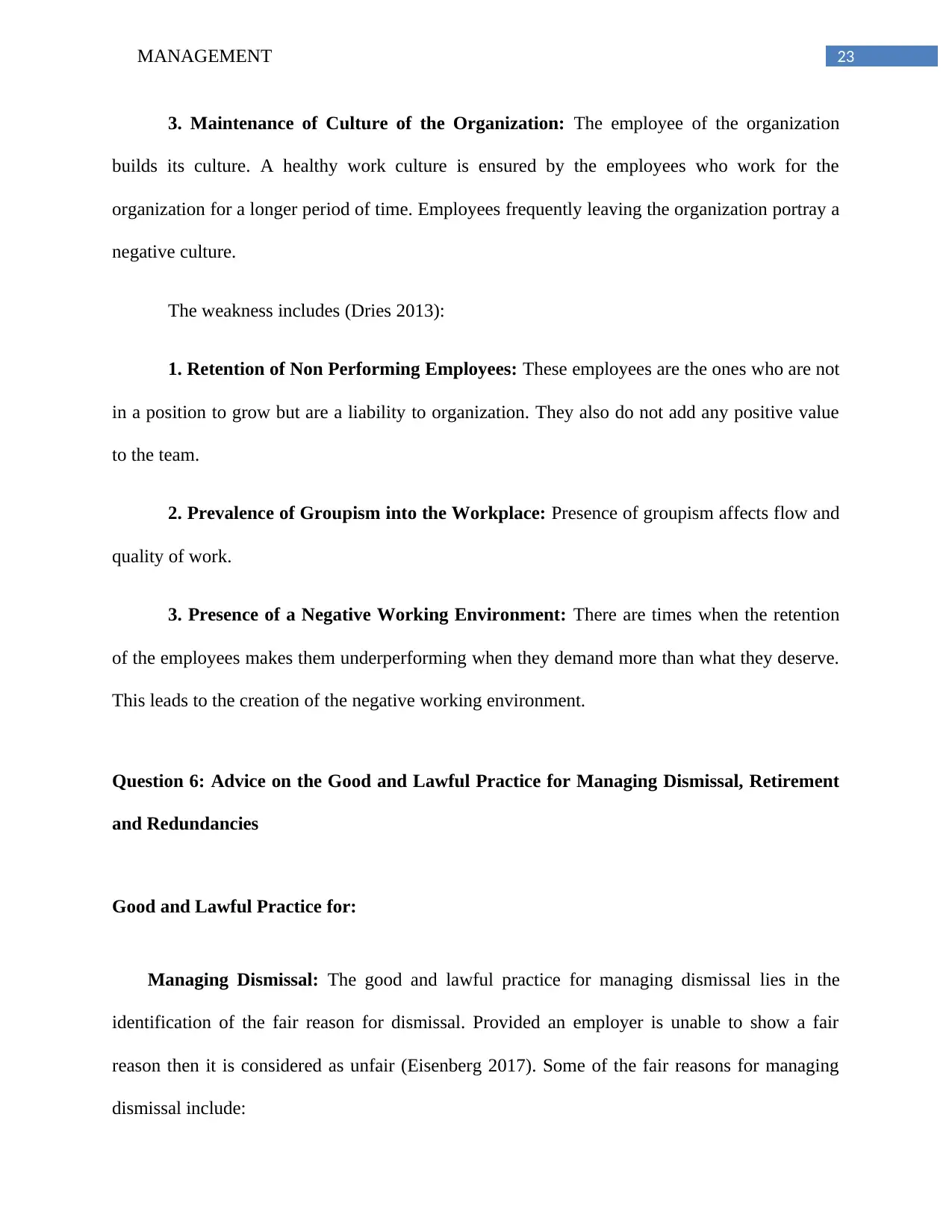
23MANAGEMENT
3. Maintenance of Culture of the Organization: The employee of the organization
builds its culture. A healthy work culture is ensured by the employees who work for the
organization for a longer period of time. Employees frequently leaving the organization portray a
negative culture.
The weakness includes (Dries 2013):
1. Retention of Non Performing Employees: These employees are the ones who are not
in a position to grow but are a liability to organization. They also do not add any positive value
to the team.
2. Prevalence of Groupism into the Workplace: Presence of groupism affects flow and
quality of work.
3. Presence of a Negative Working Environment: There are times when the retention
of the employees makes them underperforming when they demand more than what they deserve.
This leads to the creation of the negative working environment.
Question 6: Advice on the Good and Lawful Practice for Managing Dismissal, Retirement
and Redundancies
Good and Lawful Practice for:
Managing Dismissal: The good and lawful practice for managing dismissal lies in the
identification of the fair reason for dismissal. Provided an employer is unable to show a fair
reason then it is considered as unfair (Eisenberg 2017). Some of the fair reasons for managing
dismissal include:
3. Maintenance of Culture of the Organization: The employee of the organization
builds its culture. A healthy work culture is ensured by the employees who work for the
organization for a longer period of time. Employees frequently leaving the organization portray a
negative culture.
The weakness includes (Dries 2013):
1. Retention of Non Performing Employees: These employees are the ones who are not
in a position to grow but are a liability to organization. They also do not add any positive value
to the team.
2. Prevalence of Groupism into the Workplace: Presence of groupism affects flow and
quality of work.
3. Presence of a Negative Working Environment: There are times when the retention
of the employees makes them underperforming when they demand more than what they deserve.
This leads to the creation of the negative working environment.
Question 6: Advice on the Good and Lawful Practice for Managing Dismissal, Retirement
and Redundancies
Good and Lawful Practice for:
Managing Dismissal: The good and lawful practice for managing dismissal lies in the
identification of the fair reason for dismissal. Provided an employer is unable to show a fair
reason then it is considered as unfair (Eisenberg 2017). Some of the fair reasons for managing
dismissal include:
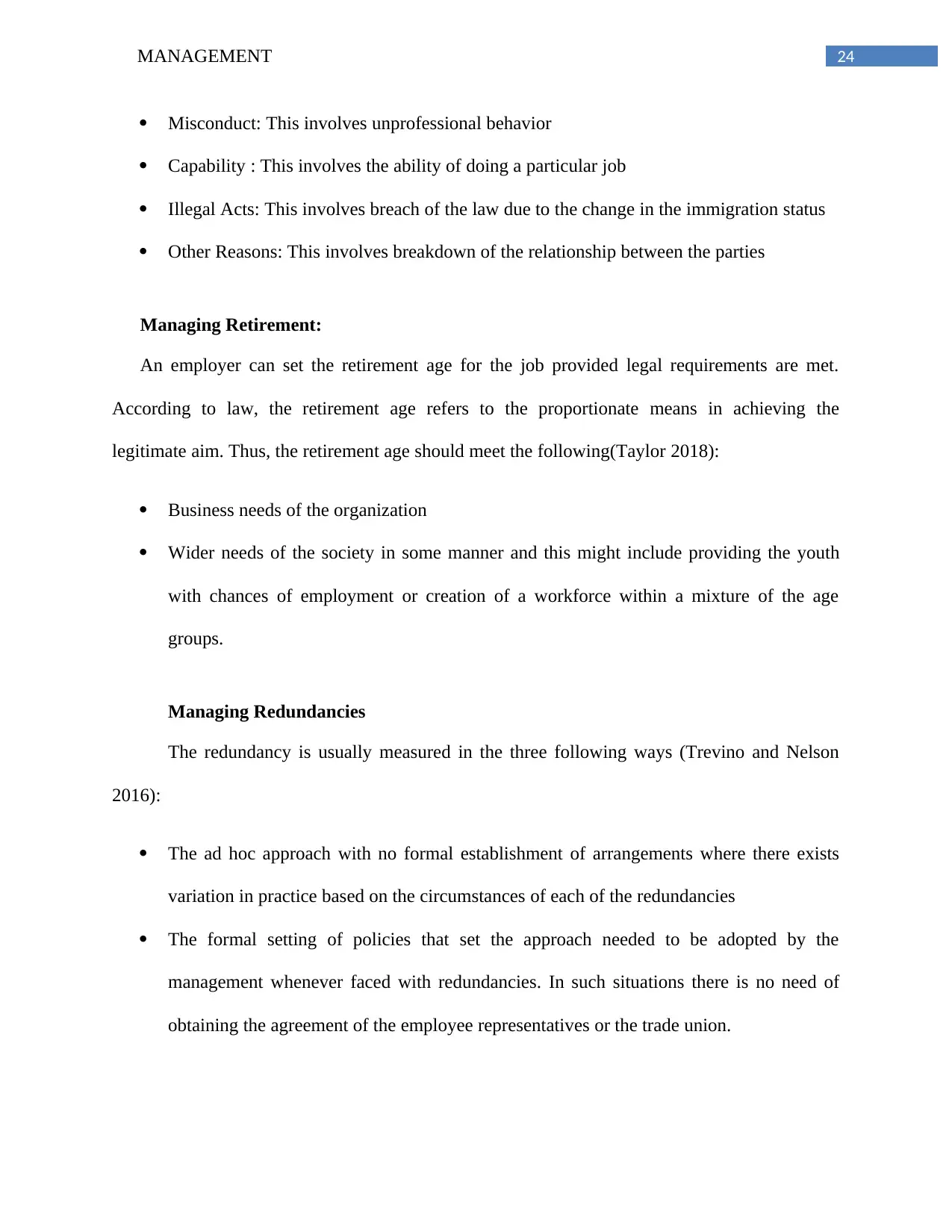
24MANAGEMENT
Misconduct: This involves unprofessional behavior
Capability : This involves the ability of doing a particular job
Illegal Acts: This involves breach of the law due to the change in the immigration status
Other Reasons: This involves breakdown of the relationship between the parties
Managing Retirement:
An employer can set the retirement age for the job provided legal requirements are met.
According to law, the retirement age refers to the proportionate means in achieving the
legitimate aim. Thus, the retirement age should meet the following(Taylor 2018):
Business needs of the organization
Wider needs of the society in some manner and this might include providing the youth
with chances of employment or creation of a workforce within a mixture of the age
groups.
Managing Redundancies
The redundancy is usually measured in the three following ways (Trevino and Nelson
2016):
The ad hoc approach with no formal establishment of arrangements where there exists
variation in practice based on the circumstances of each of the redundancies
The formal setting of policies that set the approach needed to be adopted by the
management whenever faced with redundancies. In such situations there is no need of
obtaining the agreement of the employee representatives or the trade union.
Misconduct: This involves unprofessional behavior
Capability : This involves the ability of doing a particular job
Illegal Acts: This involves breach of the law due to the change in the immigration status
Other Reasons: This involves breakdown of the relationship between the parties
Managing Retirement:
An employer can set the retirement age for the job provided legal requirements are met.
According to law, the retirement age refers to the proportionate means in achieving the
legitimate aim. Thus, the retirement age should meet the following(Taylor 2018):
Business needs of the organization
Wider needs of the society in some manner and this might include providing the youth
with chances of employment or creation of a workforce within a mixture of the age
groups.
Managing Redundancies
The redundancy is usually measured in the three following ways (Trevino and Nelson
2016):
The ad hoc approach with no formal establishment of arrangements where there exists
variation in practice based on the circumstances of each of the redundancies
The formal setting of policies that set the approach needed to be adopted by the
management whenever faced with redundancies. In such situations there is no need of
obtaining the agreement of the employee representatives or the trade union.
Paraphrase This Document
Need a fresh take? Get an instant paraphrase of this document with our AI Paraphraser
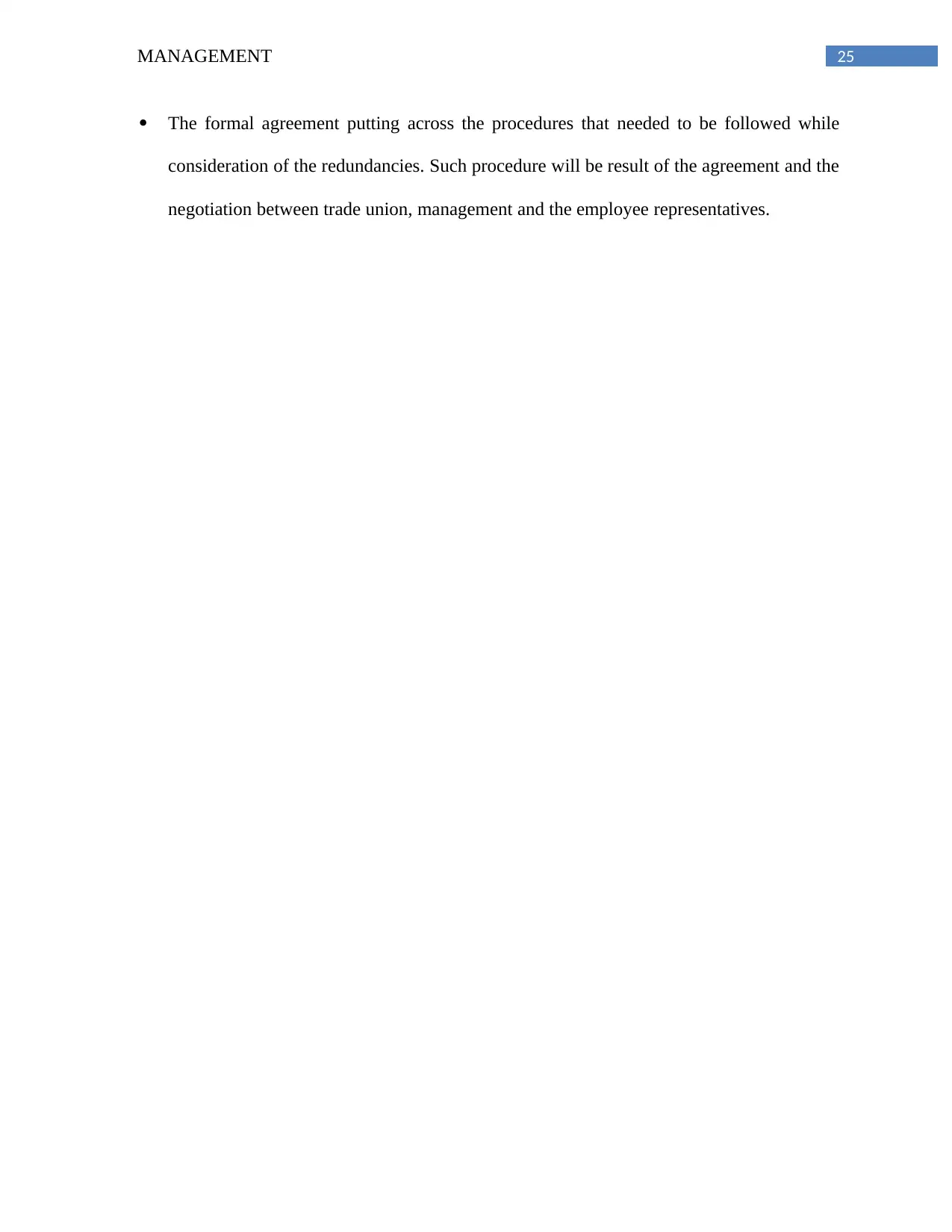
25MANAGEMENT
The formal agreement putting across the procedures that needed to be followed while
consideration of the redundancies. Such procedure will be result of the agreement and the
negotiation between trade union, management and the employee representatives.
The formal agreement putting across the procedures that needed to be followed while
consideration of the redundancies. Such procedure will be result of the agreement and the
negotiation between trade union, management and the employee representatives.
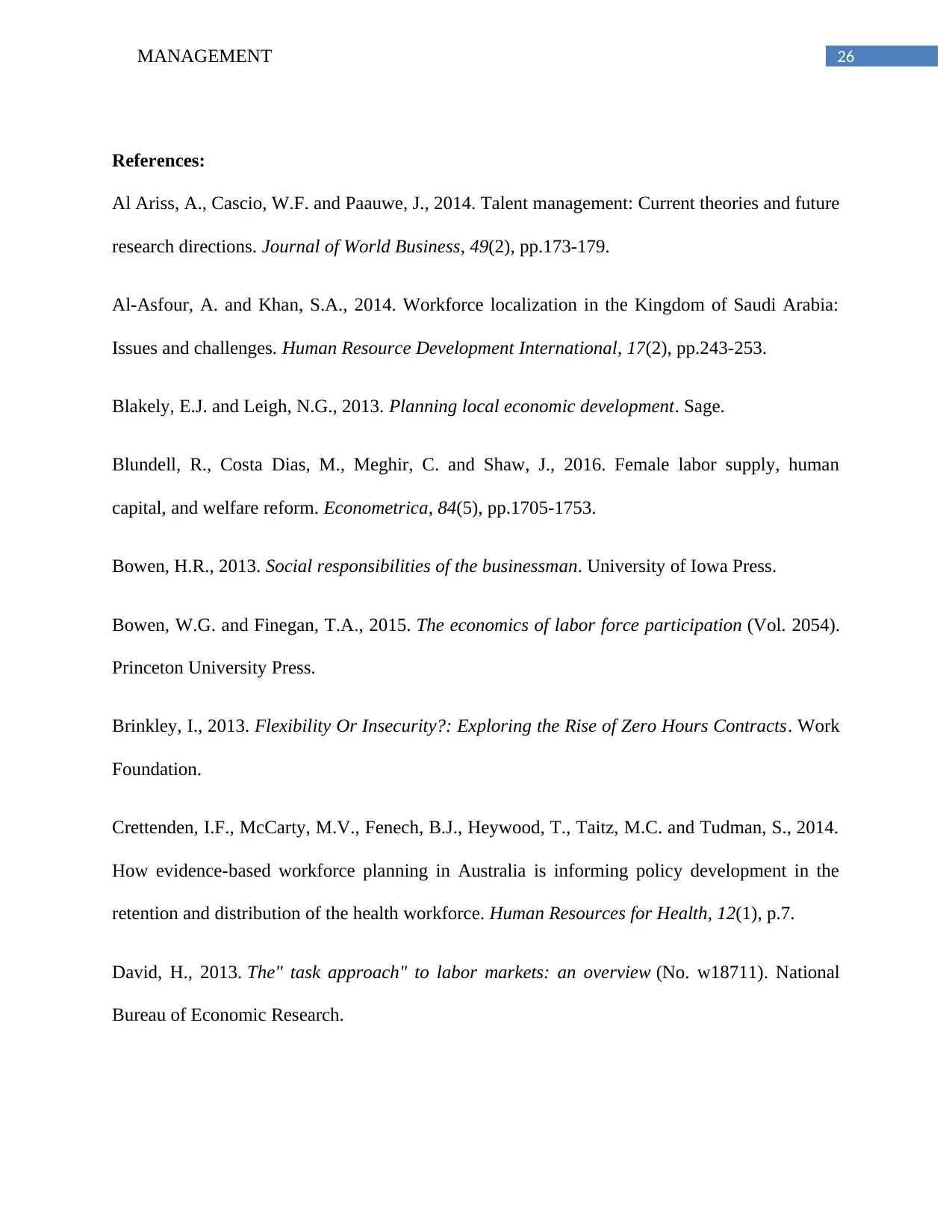
26MANAGEMENT
References:
Al Ariss, A., Cascio, W.F. and Paauwe, J., 2014. Talent management: Current theories and future
research directions. Journal of World Business, 49(2), pp.173-179.
Al-Asfour, A. and Khan, S.A., 2014. Workforce localization in the Kingdom of Saudi Arabia:
Issues and challenges. Human Resource Development International, 17(2), pp.243-253.
Blakely, E.J. and Leigh, N.G., 2013. Planning local economic development. Sage.
Blundell, R., Costa Dias, M., Meghir, C. and Shaw, J., 2016. Female labor supply, human
capital, and welfare reform. Econometrica, 84(5), pp.1705-1753.
Bowen, H.R., 2013. Social responsibilities of the businessman. University of Iowa Press.
Bowen, W.G. and Finegan, T.A., 2015. The economics of labor force participation (Vol. 2054).
Princeton University Press.
Brinkley, I., 2013. Flexibility Or Insecurity?: Exploring the Rise of Zero Hours Contracts. Work
Foundation.
Crettenden, I.F., McCarty, M.V., Fenech, B.J., Heywood, T., Taitz, M.C. and Tudman, S., 2014.
How evidence-based workforce planning in Australia is informing policy development in the
retention and distribution of the health workforce. Human Resources for Health, 12(1), p.7.
David, H., 2013. The" task approach" to labor markets: an overview (No. w18711). National
Bureau of Economic Research.
References:
Al Ariss, A., Cascio, W.F. and Paauwe, J., 2014. Talent management: Current theories and future
research directions. Journal of World Business, 49(2), pp.173-179.
Al-Asfour, A. and Khan, S.A., 2014. Workforce localization in the Kingdom of Saudi Arabia:
Issues and challenges. Human Resource Development International, 17(2), pp.243-253.
Blakely, E.J. and Leigh, N.G., 2013. Planning local economic development. Sage.
Blundell, R., Costa Dias, M., Meghir, C. and Shaw, J., 2016. Female labor supply, human
capital, and welfare reform. Econometrica, 84(5), pp.1705-1753.
Bowen, H.R., 2013. Social responsibilities of the businessman. University of Iowa Press.
Bowen, W.G. and Finegan, T.A., 2015. The economics of labor force participation (Vol. 2054).
Princeton University Press.
Brinkley, I., 2013. Flexibility Or Insecurity?: Exploring the Rise of Zero Hours Contracts. Work
Foundation.
Crettenden, I.F., McCarty, M.V., Fenech, B.J., Heywood, T., Taitz, M.C. and Tudman, S., 2014.
How evidence-based workforce planning in Australia is informing policy development in the
retention and distribution of the health workforce. Human Resources for Health, 12(1), p.7.
David, H., 2013. The" task approach" to labor markets: an overview (No. w18711). National
Bureau of Economic Research.
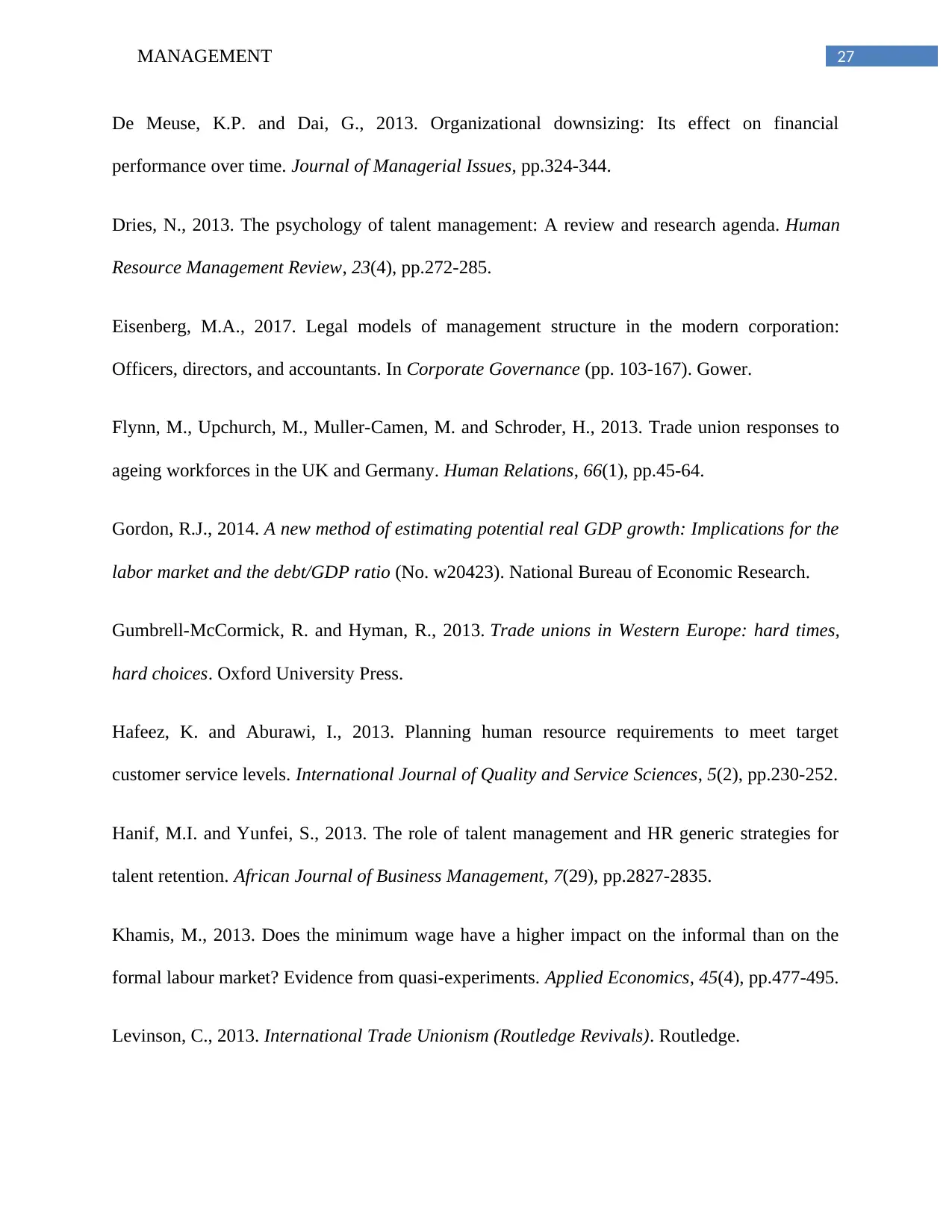
27MANAGEMENT
De Meuse, K.P. and Dai, G., 2013. Organizational downsizing: Its effect on financial
performance over time. Journal of Managerial Issues, pp.324-344.
Dries, N., 2013. The psychology of talent management: A review and research agenda. Human
Resource Management Review, 23(4), pp.272-285.
Eisenberg, M.A., 2017. Legal models of management structure in the modern corporation:
Officers, directors, and accountants. In Corporate Governance (pp. 103-167). Gower.
Flynn, M., Upchurch, M., Muller-Camen, M. and Schroder, H., 2013. Trade union responses to
ageing workforces in the UK and Germany. Human Relations, 66(1), pp.45-64.
Gordon, R.J., 2014. A new method of estimating potential real GDP growth: Implications for the
labor market and the debt/GDP ratio (No. w20423). National Bureau of Economic Research.
Gumbrell-McCormick, R. and Hyman, R., 2013. Trade unions in Western Europe: hard times,
hard choices. Oxford University Press.
Hafeez, K. and Aburawi, I., 2013. Planning human resource requirements to meet target
customer service levels. International Journal of Quality and Service Sciences, 5(2), pp.230-252.
Hanif, M.I. and Yunfei, S., 2013. The role of talent management and HR generic strategies for
talent retention. African Journal of Business Management, 7(29), pp.2827-2835.
Khamis, M., 2013. Does the minimum wage have a higher impact on the informal than on the
formal labour market? Evidence from quasi-experiments. Applied Economics, 45(4), pp.477-495.
Levinson, C., 2013. International Trade Unionism (Routledge Revivals). Routledge.
De Meuse, K.P. and Dai, G., 2013. Organizational downsizing: Its effect on financial
performance over time. Journal of Managerial Issues, pp.324-344.
Dries, N., 2013. The psychology of talent management: A review and research agenda. Human
Resource Management Review, 23(4), pp.272-285.
Eisenberg, M.A., 2017. Legal models of management structure in the modern corporation:
Officers, directors, and accountants. In Corporate Governance (pp. 103-167). Gower.
Flynn, M., Upchurch, M., Muller-Camen, M. and Schroder, H., 2013. Trade union responses to
ageing workforces in the UK and Germany. Human Relations, 66(1), pp.45-64.
Gordon, R.J., 2014. A new method of estimating potential real GDP growth: Implications for the
labor market and the debt/GDP ratio (No. w20423). National Bureau of Economic Research.
Gumbrell-McCormick, R. and Hyman, R., 2013. Trade unions in Western Europe: hard times,
hard choices. Oxford University Press.
Hafeez, K. and Aburawi, I., 2013. Planning human resource requirements to meet target
customer service levels. International Journal of Quality and Service Sciences, 5(2), pp.230-252.
Hanif, M.I. and Yunfei, S., 2013. The role of talent management and HR generic strategies for
talent retention. African Journal of Business Management, 7(29), pp.2827-2835.
Khamis, M., 2013. Does the minimum wage have a higher impact on the informal than on the
formal labour market? Evidence from quasi-experiments. Applied Economics, 45(4), pp.477-495.
Levinson, C., 2013. International Trade Unionism (Routledge Revivals). Routledge.
Secure Best Marks with AI Grader
Need help grading? Try our AI Grader for instant feedback on your assignments.
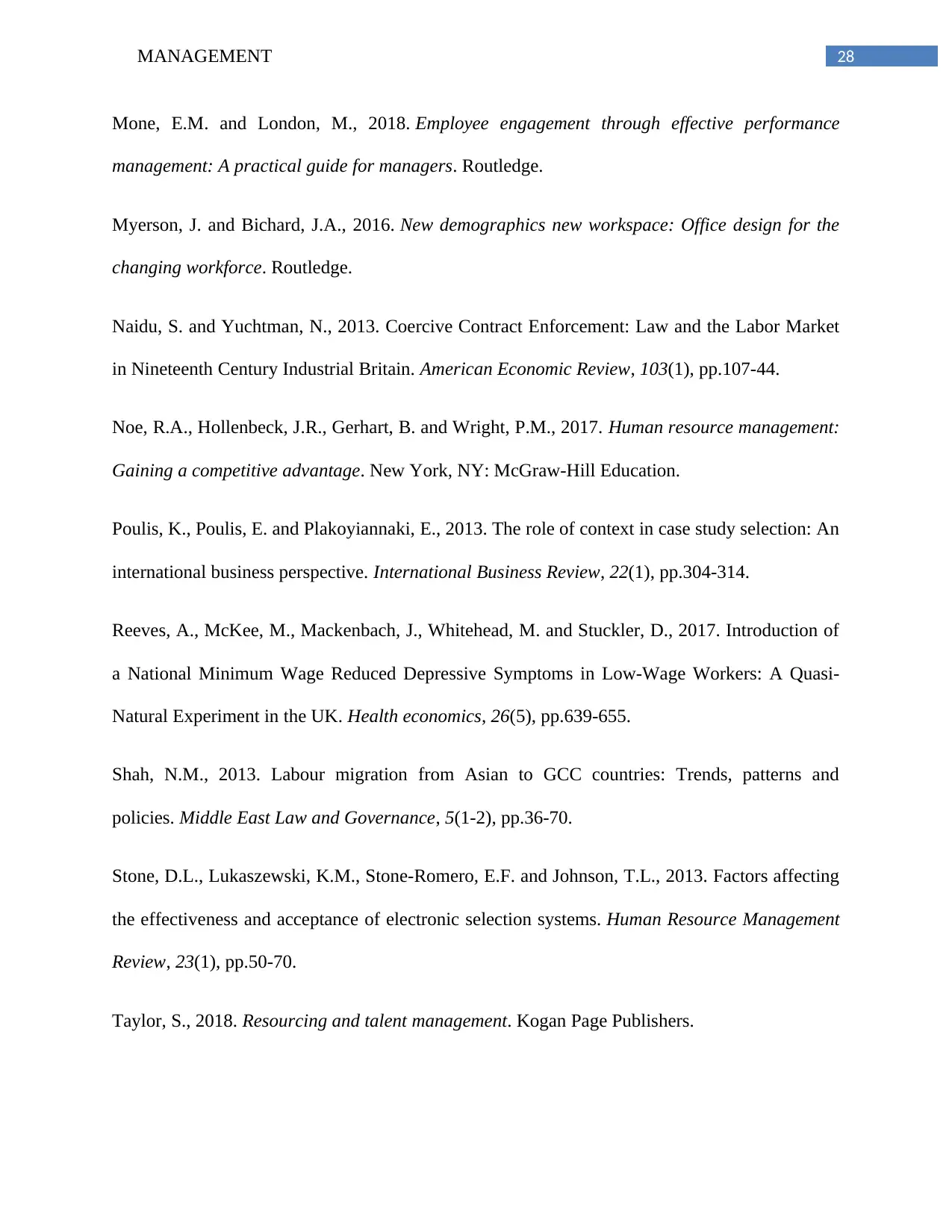
28MANAGEMENT
Mone, E.M. and London, M., 2018. Employee engagement through effective performance
management: A practical guide for managers. Routledge.
Myerson, J. and Bichard, J.A., 2016. New demographics new workspace: Office design for the
changing workforce. Routledge.
Naidu, S. and Yuchtman, N., 2013. Coercive Contract Enforcement: Law and the Labor Market
in Nineteenth Century Industrial Britain. American Economic Review, 103(1), pp.107-44.
Noe, R.A., Hollenbeck, J.R., Gerhart, B. and Wright, P.M., 2017. Human resource management:
Gaining a competitive advantage. New York, NY: McGraw-Hill Education.
Poulis, K., Poulis, E. and Plakoyiannaki, E., 2013. The role of context in case study selection: An
international business perspective. International Business Review, 22(1), pp.304-314.
Reeves, A., McKee, M., Mackenbach, J., Whitehead, M. and Stuckler, D., 2017. Introduction of
a National Minimum Wage Reduced Depressive Symptoms in Low‐Wage Workers: A Quasi‐
Natural Experiment in the UK. Health economics, 26(5), pp.639-655.
Shah, N.M., 2013. Labour migration from Asian to GCC countries: Trends, patterns and
policies. Middle East Law and Governance, 5(1-2), pp.36-70.
Stone, D.L., Lukaszewski, K.M., Stone-Romero, E.F. and Johnson, T.L., 2013. Factors affecting
the effectiveness and acceptance of electronic selection systems. Human Resource Management
Review, 23(1), pp.50-70.
Taylor, S., 2018. Resourcing and talent management. Kogan Page Publishers.
Mone, E.M. and London, M., 2018. Employee engagement through effective performance
management: A practical guide for managers. Routledge.
Myerson, J. and Bichard, J.A., 2016. New demographics new workspace: Office design for the
changing workforce. Routledge.
Naidu, S. and Yuchtman, N., 2013. Coercive Contract Enforcement: Law and the Labor Market
in Nineteenth Century Industrial Britain. American Economic Review, 103(1), pp.107-44.
Noe, R.A., Hollenbeck, J.R., Gerhart, B. and Wright, P.M., 2017. Human resource management:
Gaining a competitive advantage. New York, NY: McGraw-Hill Education.
Poulis, K., Poulis, E. and Plakoyiannaki, E., 2013. The role of context in case study selection: An
international business perspective. International Business Review, 22(1), pp.304-314.
Reeves, A., McKee, M., Mackenbach, J., Whitehead, M. and Stuckler, D., 2017. Introduction of
a National Minimum Wage Reduced Depressive Symptoms in Low‐Wage Workers: A Quasi‐
Natural Experiment in the UK. Health economics, 26(5), pp.639-655.
Shah, N.M., 2013. Labour migration from Asian to GCC countries: Trends, patterns and
policies. Middle East Law and Governance, 5(1-2), pp.36-70.
Stone, D.L., Lukaszewski, K.M., Stone-Romero, E.F. and Johnson, T.L., 2013. Factors affecting
the effectiveness and acceptance of electronic selection systems. Human Resource Management
Review, 23(1), pp.50-70.
Taylor, S., 2018. Resourcing and talent management. Kogan Page Publishers.
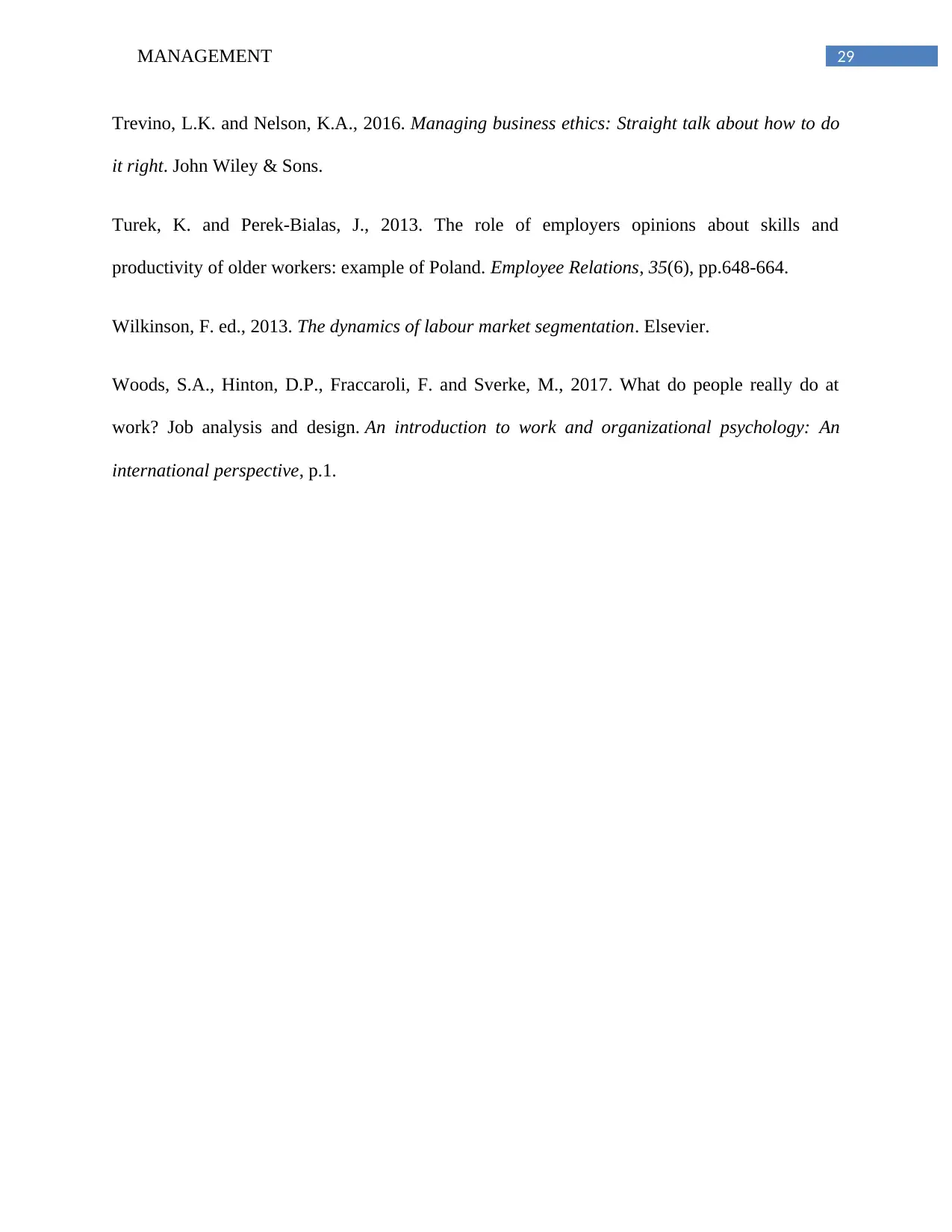
29MANAGEMENT
Trevino, L.K. and Nelson, K.A., 2016. Managing business ethics: Straight talk about how to do
it right. John Wiley & Sons.
Turek, K. and Perek-Bialas, J., 2013. The role of employers opinions about skills and
productivity of older workers: example of Poland. Employee Relations, 35(6), pp.648-664.
Wilkinson, F. ed., 2013. The dynamics of labour market segmentation. Elsevier.
Woods, S.A., Hinton, D.P., Fraccaroli, F. and Sverke, M., 2017. What do people really do at
work? Job analysis and design. An introduction to work and organizational psychology: An
international perspective, p.1.
Trevino, L.K. and Nelson, K.A., 2016. Managing business ethics: Straight talk about how to do
it right. John Wiley & Sons.
Turek, K. and Perek-Bialas, J., 2013. The role of employers opinions about skills and
productivity of older workers: example of Poland. Employee Relations, 35(6), pp.648-664.
Wilkinson, F. ed., 2013. The dynamics of labour market segmentation. Elsevier.
Woods, S.A., Hinton, D.P., Fraccaroli, F. and Sverke, M., 2017. What do people really do at
work? Job analysis and design. An introduction to work and organizational psychology: An
international perspective, p.1.
1 out of 30
Related Documents
Your All-in-One AI-Powered Toolkit for Academic Success.
+13062052269
info@desklib.com
Available 24*7 on WhatsApp / Email
![[object Object]](/_next/static/media/star-bottom.7253800d.svg)
Unlock your academic potential
© 2024 | Zucol Services PVT LTD | All rights reserved.




